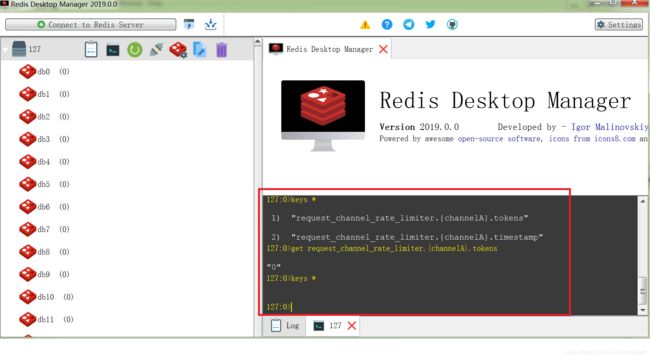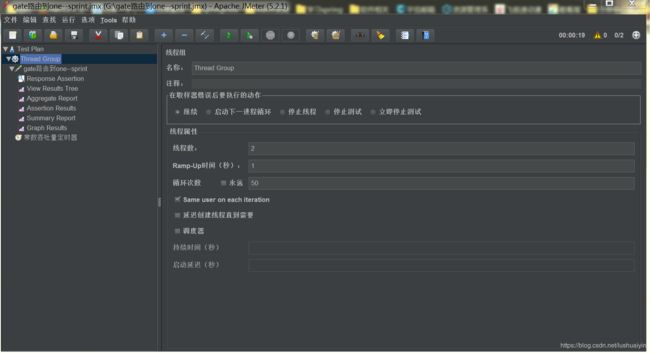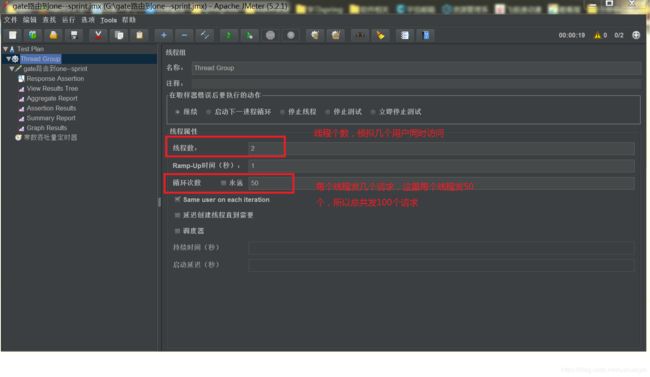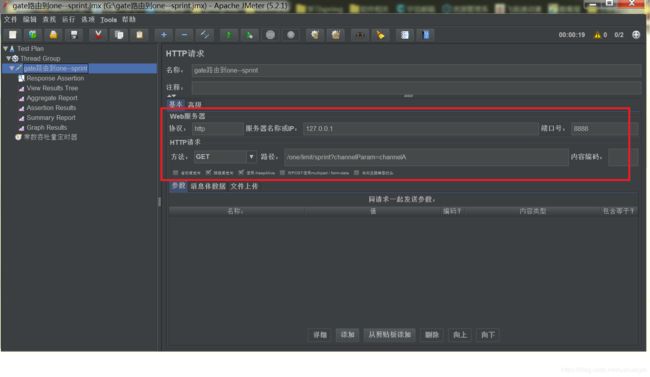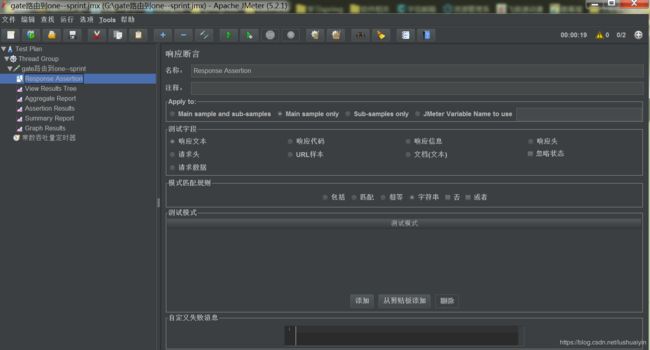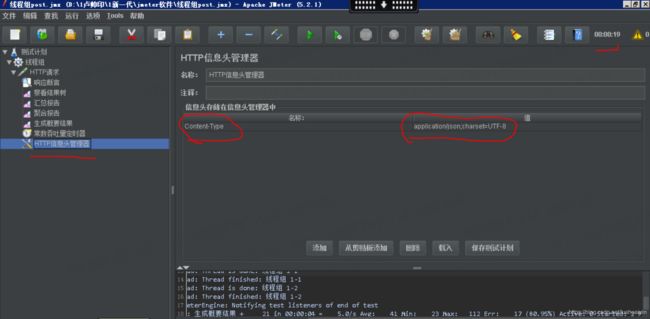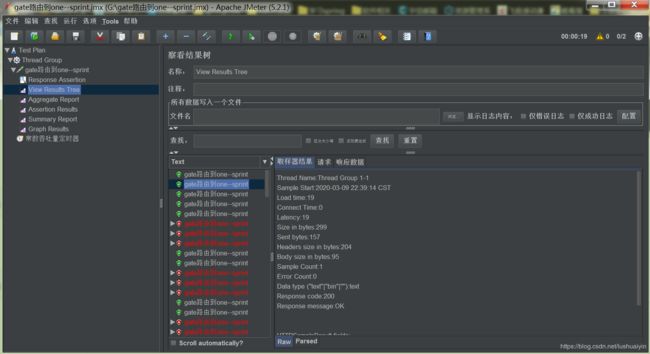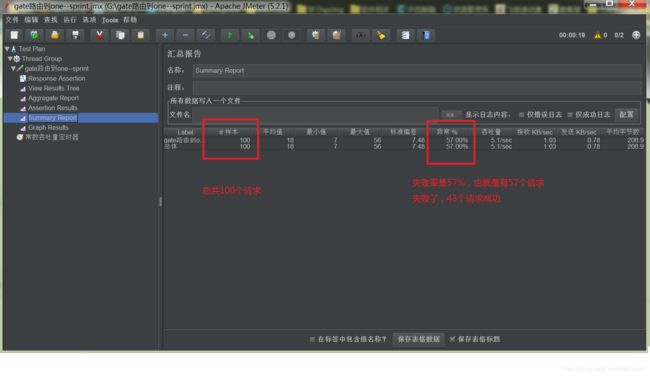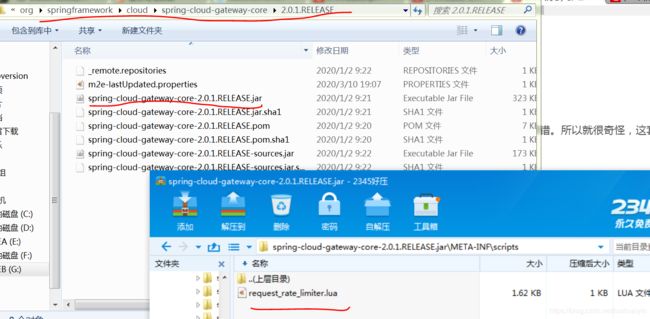springcloudgateway实现自定义限流
目录
概要
1,限流的原理
2,自定义限流的代码实现
3,限流工具的使用
复杂例子和完整代码
疑难杂症1:限流不起作用
疑难杂症2:限流的类取不到前面HeaderDealFilter中我放入header中的信息
概要
springcloudgateway的限流网上有很多介绍的,官网上说的也很详细。我想说的是限流的key要有不同的限流配置参数,
实现自定义限流。
通用的例子是,你定义一个KeyResolver,然后再在yml配置限流需要得2个参数:redis-rate-limiter.replenishRate(限流速率),redis-rate-limiter.burstCapacity(令牌桶大小)。
这样限流就做好了。
例子不再贴代码。
这样的限流是根据你定义的KeyResolver(可以是url,IP,系统名称,用户参数等,总之就是一个字符串,这就是限流的key或者叫限流的维度),用配置的replenishRate(限流速率)和burstCapacity(令牌桶大小)去限流。
问题是:我想在KeyResolver上,每个具体的KeyResolver值有不同的replenishRate(限流速率)和burstCapacity(令牌桶大小),
而不是用yml中写死的那个。比如你要根据IP进行限流,你定义你的KeyResolver为:
@Bean
public KeyResolver hostAddrKeyResolver2() {
return exchange -> Mono.just(exchange.getRequest().getRemoteAddress().getHostName());
}定义的限流参数为:
redis-rate-limiter.replenishRate: 1
redis-rate-limiter.burstCapacity: 2
那么请求的所有请求来得IP都是这一个限流配置。
我想实现自定义限流,比如同样按照IP进行限流,但是192.168.2.11的限流是
redis-rate-limiter.replenishRate: 1
redis-rate-limiter.burstCapacity: 2
192.168.2.12的限流是
redis-rate-limiter.replenishRate: 100
redis-rate-limiter.burstCapacity: 200
192.168.2.13的限流是
redis-rate-limiter.replenishRate: 500
redis-rate-limiter.burstCapacity: 2000
这才是实际场景下的客户需求。那要怎么实现呢?
这就是我要说的自定义限流。
文章结构主要如下,只讲干货:
1,限流的原理
限流目前通用的是令牌桶算法,有2个关键参数 replenishRate(限流速率),burstCapacity(令牌桶大小)
限流速率可以理解为,1秒钟放出几个令牌到令牌桶。
令牌桶大小就是令牌桶最多能放几个令牌。
限流的核心思路就是,每过来一个请求,必须从令牌桶取一个令牌,有了这个通行证,才不会被限流。
想象一个水管往一个桶匀速的注入水(1秒2滴),有个桶能装100滴水。
有请求过来后,从桶里取一滴水才能通行,取不到水的请求就被拦截了。
这个结构,令牌桶不是必须的,因为直接从水管取水也是可以的,这就是漏桶算法。
加一个令牌桶就是有机会缓存一桶水。当请求少的时候,令牌桶的水是多余流速 (1秒2滴)的。
这样就发生一种现象,最开始的时候,桶里可能存满了水(100滴),这时候有大量请求一起访问。
那么在最初的1秒,这个令牌桶结构可以提供100滴水,而不是2滴。假如后面请求还是很多,那么
令牌桶的水就取决取水管流速的大小(即注入的水马上就被抢光了),这时候也就是限流的阶段了。
这个令牌桶也是原来漏桶算法的改进。
回到代码实现,在代码中怎么实现这个原理呢?
首先对请求限流,首先想到的必然是filter拦截器。
满足条件的放行,不满足的拒绝。
然后,限流维度的定义。
我们既然要根据请求的不同特征取限流,那必然要从request中获取这些信息。
所以,request能获取到的信息都可以作为限流的维度。
比如,你可以从request获取到IP地址,URL,parameter,cookie,还能从header中获取一些信息。
这些信息都可以作为限流的维度。
最后,令牌桶要根据具体的限流维度的key值,运转水管和水桶。
这个临时信息放在那里呢?
令牌桶的算法是固定的,你桶里目前有没有水,这个信息是实时变化的。必须存起来,下一个请求过来时,
才能决定限流是否通过。
这些临时信息存储的地方也是有很多选择。
比如,我可以放在java的内存中,可以放在数据库中,可以放在文件中。
还可以放在redis中。
这些方案最终影响是不同的。
在多实例分布式的场景中,如果放在内存冲,如果没有做内存同步,那么每个实例内存中的令牌桶都是各自为营。
你定义的限流速率和令牌桶大小都是每个实例中各一套。
如果我想所有应用实例总共的请求做一个公共的限流,那么就必须把令牌桶放在一个公共的地方,
这样不管哪个应用实例来得请求,都是在公共的这个令牌桶排队,也就是全局的限流。
目前通用的方案都是redis。redis速度快,本身在分布式架构中做session和缓存服务器,所以
目前通用的限流都依赖redis。
说了这么多,看看springcloudgateway的filter怎么实现的:
# - name: RequestRateLimite
# args:
# key-resolver: "#{@uriKeyResolverMy}"
# redis-rate-limiter.replenishRate: 1
# redis-rate-limiter.burstCapacity: 2这个filter其实是:RequestRateLimiterGatewayFilterFactory
源码:
/*
* Copyright 2013-2017 the original author or authors.
*
* Licensed under the Apache License, Version 2.0 (the "License");
* you may not use this file except in compliance with the License.
* You may obtain a copy of the License at
*
* http://www.apache.org/licenses/LICENSE-2.0
*
* Unless required by applicable law or agreed to in writing, software
* distributed under the License is distributed on an "AS IS" BASIS,
* WITHOUT WARRANTIES OR CONDITIONS OF ANY KIND, either express or implied.
* See the License for the specific language governing permissions and
* limitations under the License.
*
*/
package org.springframework.cloud.gateway.filter.factory;
import org.springframework.cloud.gateway.filter.GatewayFilter;
import org.springframework.cloud.gateway.filter.ratelimit.KeyResolver;
import org.springframework.cloud.gateway.filter.ratelimit.RateLimiter;
import org.springframework.cloud.gateway.route.Route;
import org.springframework.cloud.gateway.support.ServerWebExchangeUtils;
import org.springframework.http.HttpStatus;
import java.util.Map;
/**
* User Request Rate Limiter filter. See https://stripe.com/blog/rate-limiters and
*/
public class RequestRateLimiterGatewayFilterFactory extends AbstractGatewayFilterFactory {
public static final String KEY_RESOLVER_KEY = "keyResolver";
private final RateLimiter defaultRateLimiter;
private final KeyResolver defaultKeyResolver;
public RequestRateLimiterGatewayFilterFactory(RateLimiter defaultRateLimiter,
KeyResolver defaultKeyResolver) {
super(Config.class);
this.defaultRateLimiter = defaultRateLimiter;
this.defaultKeyResolver = defaultKeyResolver;
}
public KeyResolver getDefaultKeyResolver() {
return defaultKeyResolver;
}
public RateLimiter getDefaultRateLimiter() {
return defaultRateLimiter;
}
@SuppressWarnings("unchecked")
@Override
public GatewayFilter apply(Config config) {
KeyResolver resolver = (config.keyResolver == null) ? defaultKeyResolver : config.keyResolver;
RateLimiter 关键代码就是:
@SuppressWarnings("unchecked")
@Override
public GatewayFilter apply(Config config) {
KeyResolver resolver = (config.keyResolver == null) ? defaultKeyResolver : config.keyResolver;
RateLimiter那么继续看这个limiter.isAllowed的实现代码
package org.springframework.cloud.gateway.filter.ratelimit;
import java.time.Instant;
import java.util.ArrayList;
import java.util.Arrays;
import java.util.HashMap;
import java.util.List;
import java.util.concurrent.atomic.AtomicBoolean;
import javax.validation.constraints.Min;
import org.apache.commons.logging.Log;
import org.apache.commons.logging.LogFactory;
import org.jetbrains.annotations.NotNull;
import reactor.core.publisher.Flux;
import reactor.core.publisher.Mono;
import org.springframework.beans.BeansException;
import org.springframework.boot.context.properties.ConfigurationProperties;
import org.springframework.context.ApplicationContext;
import org.springframework.context.ApplicationContextAware;
import org.springframework.data.redis.core.ReactiveRedisTemplate;
import org.springframework.data.redis.core.script.RedisScript;
import org.springframework.validation.Validator;
import org.springframework.validation.annotation.Validated;
/**
* See https://stripe.com/blog/rate-limiters and
* https://gist.github.com/ptarjan/e38f45f2dfe601419ca3af937fff574d#file-1-check_request_rate_limiter-rb-L11-L34
*
* @author Spencer Gibb
*/
@ConfigurationProperties("spring.cloud.gateway.redis-rate-limiter")
public class RedisRateLimiter extends AbstractRateLimiter implements ApplicationContextAware {
@Deprecated
public static final String REPLENISH_RATE_KEY = "replenishRate";
@Deprecated
public static final String BURST_CAPACITY_KEY = "burstCapacity";
public static final String CONFIGURATION_PROPERTY_NAME = "redis-rate-limiter";
public static final String REDIS_SCRIPT_NAME = "redisRequestRateLimiterScript";
public static final String REMAINING_HEADER = "X-RateLimit-Remaining";
public static final String REPLENISH_RATE_HEADER = "X-RateLimit-Replenish-Rate";
public static final String BURST_CAPACITY_HEADER = "X-RateLimit-Burst-Capacity";
private Log log = LogFactory.getLog(getClass());
private ReactiveRedisTemplate redisTemplate;
private RedisScript> script;
private AtomicBoolean initialized = new AtomicBoolean(false);
private Config defaultConfig;
// configuration properties
/** Whether or not to include headers containing rate limiter information, defaults to true. */
private boolean includeHeaders = true;
/** The name of the header that returns number of remaining requests during the current second. */
private String remainingHeader = REMAINING_HEADER;
/** The name of the header that returns the replenish rate configuration. */
private String replenishRateHeader = REPLENISH_RATE_HEADER;
/** The name of the header that returns the burst capacity configuration. */
private String burstCapacityHeader = BURST_CAPACITY_HEADER;
public RedisRateLimiter(ReactiveRedisTemplate redisTemplate,
RedisScript> script, Validator validator) {
super(Config.class, CONFIGURATION_PROPERTY_NAME, validator);
this.redisTemplate = redisTemplate;
this.script = script;
initialized.compareAndSet(false, true);
}
public RedisRateLimiter(int defaultReplenishRate, int defaultBurstCapacity) {
super(Config.class, CONFIGURATION_PROPERTY_NAME, null);
this.defaultConfig = new Config()
.setReplenishRate(defaultReplenishRate)
.setBurstCapacity(defaultBurstCapacity);
}
public boolean isIncludeHeaders() {
return includeHeaders;
}
public void setIncludeHeaders(boolean includeHeaders) {
this.includeHeaders = includeHeaders;
}
public String getRemainingHeader() {
return remainingHeader;
}
public void setRemainingHeader(String remainingHeader) {
this.remainingHeader = remainingHeader;
}
public String getReplenishRateHeader() {
return replenishRateHeader;
}
public void setReplenishRateHeader(String replenishRateHeader) {
this.replenishRateHeader = replenishRateHeader;
}
public String getBurstCapacityHeader() {
return burstCapacityHeader;
}
public void setBurstCapacityHeader(String burstCapacityHeader) {
this.burstCapacityHeader = burstCapacityHeader;
}
@Override
@SuppressWarnings("unchecked")
public void setApplicationContext(ApplicationContext context) throws BeansException {
if (initialized.compareAndSet(false, true)) {
this.redisTemplate = context.getBean("stringReactiveRedisTemplate", ReactiveRedisTemplate.class);
this.script = context.getBean(REDIS_SCRIPT_NAME, RedisScript.class);
if (context.getBeanNamesForType(Validator.class).length > 0) {
this.setValidator(context.getBean(Validator.class));
}
}
}
/* for testing */ Config getDefaultConfig() {
return defaultConfig;
}
/**
* This uses a basic token bucket algorithm and relies on the fact that Redis scripts
* execute atomically. No other operations can run between fetching the count and
* writing the new count.
*/
@Override
@SuppressWarnings("unchecked")
public Mono isAllowed(String routeId, String id) {
if (!this.initialized.get()) {
throw new IllegalStateException("RedisRateLimiter is not initialized");
}
Config routeConfig = getConfig().getOrDefault(routeId, defaultConfig);
if (routeConfig == null) {
throw new IllegalArgumentException("No Configuration found for route " + routeId);
}
// How many requests per second do you want a user to be allowed to do?
int replenishRate = routeConfig.getReplenishRate();
// How much bursting do you want to allow?
int burstCapacity = routeConfig.getBurstCapacity();
try {
List keys = getKeys(id);
// The arguments to the LUA script. time() returns unixtime in seconds.
List scriptArgs = Arrays.asList(replenishRate + "", burstCapacity + "",
Instant.now().getEpochSecond() + "", "1");
// allowed, tokens_left = redis.eval(SCRIPT, keys, args)
Flux> flux = this.redisTemplate.execute(this.script, keys, scriptArgs);
// .log("redisratelimiter", Level.FINER);
return flux.onErrorResume(throwable -> Flux.just(Arrays.asList(1L, -1L)))
.reduce(new ArrayList(), (longs, l) -> {
longs.addAll(l);
return longs;
}) .map(results -> {
boolean allowed = results.get(0) == 1L;
Long tokensLeft = results.get(1);
Response response = new Response(allowed, getHeaders(routeConfig, tokensLeft));
if (log.isDebugEnabled()) {
log.debug("response: " + response);
}
return response;
});
}
catch (Exception e) {
/*
* We don't want a hard dependency on Redis to allow traffic. Make sure to set
* an alert so you know if this is happening too much. Stripe's observed
* failure rate is 0.01%.
*/
log.error("Error determining if user allowed from redis", e);
}
return Mono.just(new Response(true, getHeaders(routeConfig, -1L)));
}
@NotNull
public HashMap getHeaders(Config config, Long tokensLeft) {
HashMap headers = new HashMap<>();
headers.put(this.remainingHeader, tokensLeft.toString());
headers.put(this.replenishRateHeader, String.valueOf(config.getReplenishRate()));
headers.put(this.burstCapacityHeader, String.valueOf(config.getBurstCapacity()));
return headers;
}
static List getKeys(String id) {
// use `{}` around keys to use Redis Key hash tags
// this allows for using redis cluster
// Make a unique key per user.
String prefix = "request_rate_limiter.{" + id;
// You need two Redis keys for Token Bucket.
String tokenKey = prefix + "}.tokens";
String timestampKey = prefix + "}.timestamp";
return Arrays.asList(tokenKey, timestampKey);
}
@Validated
public static class Config {
@Min(1)
private int replenishRate;
@Min(1)
private int burstCapacity = 1;
public int getReplenishRate() {
return replenishRate;
}
public Config setReplenishRate(int replenishRate) {
this.replenishRate = replenishRate;
return this;
}
public int getBurstCapacity() {
return burstCapacity;
}
public Config setBurstCapacity(int burstCapacity) {
this.burstCapacity = burstCapacity;
return this;
}
@Override
public String toString() {
return "Config{" +
"replenishRate=" + replenishRate +
", burstCapacity=" + burstCapacity +
'}';
}
}
}
这个默认就是RedisRateLimiter
关键代码:
@Override
@SuppressWarnings("unchecked")
public Mono isAllowed(String routeId, String id) {
if (!this.initialized.get()) {
throw new IllegalStateException("RedisRateLimiter is not initialized");
}
Config routeConfig = getConfig().getOrDefault(routeId, defaultConfig);
if (routeConfig == null) {
throw new IllegalArgumentException("No Configuration found for route " + routeId);
}
// How many requests per second do you want a user to be allowed to do?
int replenishRate = routeConfig.getReplenishRate();
// How much bursting do you want to allow?
int burstCapacity = routeConfig.getBurstCapacity();
try {
List keys = getKeys(id);
// The arguments to the LUA script. time() returns unixtime in seconds.
List scriptArgs = Arrays.asList(replenishRate + "", burstCapacity + "",
Instant.now().getEpochSecond() + "", "1");
// allowed, tokens_left = redis.eval(SCRIPT, keys, args)
Flux> flux = this.redisTemplate.execute(this.script, keys, scriptArgs);
// .log("redisratelimiter", Level.FINER);
return flux.onErrorResume(throwable -> Flux.just(Arrays.asList(1L, -1L)))
.reduce(new ArrayList(), (longs, l) -> {
longs.addAll(l);
return longs;
}) .map(results -> {
boolean allowed = results.get(0) == 1L;
Long tokensLeft = results.get(1);
Response response = new Response(allowed, getHeaders(routeConfig, tokensLeft));
if (log.isDebugEnabled()) {
log.debug("response: " + response);
}
return response;
});
}
catch (Exception e) {
/*
* We don't want a hard dependency on Redis to allow traffic. Make sure to set
* an alert so you know if this is happening too much. Stripe's observed
* failure rate is 0.01%.
*/
log.error("Error determining if user allowed from redis", e);
}
return Mono.just(new Response(true, getHeaders(routeConfig, -1L)));
} 看到限流的关键参数了吗?
int replenishRate = routeConfig.getReplenishRate();
int burstCapacity = routeConfig.getBurstCapacity();
这个参数会传入redis的执行脚本中。令牌桶算法就是用redis的脚本来实现的。这个脚本我们可以不用去研究。
// The arguments to the LUA script. time() returns unixtime in seconds.
List
Instant.now().getEpochSecond() + "", "1");
// allowed, tokens_left = redis.eval(SCRIPT, keys, args)
Flux
这个redis脚本藏在spring-cloud-gateway-core-2.0.1.RELEASE.jar 中的 \META-INF\scripts
request_rate_limiter.lua
代码就不贴了。
这个方法public Mono
中的参数routeId和id就是调用他的类RequestRateLimiterGatewayFilterFactory
这样传进去的:
limiter.isAllowed(route.getId(), key).flatMap。。。
这个route.getId()就是我们微服务的名字,这个key就是我们自己定义的KeyResolver的返回值。
所以,你知道为什么限流必须定义KeyResolver了吗。
这个KeyResolver我们按照自己的业务逻辑随便写,来定义我们按照什么限流。
到目前为止,我们搞懂了限流算法以及这个算法具体的代码实现。
下面就要修改这个代码实现我们的自定义限流。
2,自定义限流的代码实现
从限流的原理上看,令牌桶需要3个关键参数。replenishRate(限流速率),burstCapacity(令牌桶大小)。
还有一个就是限流的维度(或者叫限流的key)。
你可以理解为刚才讲的那一套水管和桶就是一个限流维度。
你如,你要按照请求的IP进行限流,那么限流的维度就是IP。
实际情况就是,当请求过来时,一个IP地址就创建一套令牌桶。
就好比你去买票,卖票的窗口是按照地域来限流的。假定,每个窗口的售票员公祖能力都一样,
每秒只能服务2个人(限流速率)。每个窗口都一样。
那么从河北来的人排一队,从山西来的人排一队。
河北和山西就是你的请求IP,每个窗口就是一套令牌桶。
springcloudgateway默认支持按照各种维度排队,只要我们定义一个KeyResolver就可以了。
这个你想怎么定义都可以,比如我想按照性别来排队,按照年龄,职业来排队等等。
这个网上都有很多例子,核心就是定义好这个KeyResolver就可以。
例如:
@Bean
public KeyResolver hostAddrKeyResolver2() {
return exchange -> Mono.just(exchange.getRequest().getRemoteAddress().getHostName());
}
还是回到自定义限流的问题上。
现在无论是按哪种类型来排队,都没问题。自定义限流要做的就是:
根据排队的人,来改变售票员的能力。
当一个普通人来买票时,售票员还是1秒只能服务2个人。
当有社会名流,军人,有紧急事情的人,来买票时。就单独再给这类人开一个窗口,
这个窗口的售票员能力也可以改变。比如军人窗口的售票员1秒服务5个人。
代码上要实现自定义限流要改3个地方:
1,限流维度(从request获取的数据做业务逻辑上的处理,创造一个字符串作为限流的key,放入header,方便后面获取)
2,获取限流维度,即定义KeyResolver
3,修改RedisRateLimiter实现,重写public Mono
1,写一个GlobalFilter: HeaderDealFilter用于在header放一个字符串,作为我们自定义限流的key
package com.example.gate.filter;
import java.util.HashMap;
import java.util.Iterator;
import java.util.List;
import java.util.Map;
import java.util.function.Consumer;
import org.slf4j.Logger;
import org.slf4j.LoggerFactory;
import org.springframework.cloud.gateway.filter.GatewayFilterChain;
import org.springframework.cloud.gateway.filter.GlobalFilter;
import org.springframework.core.Ordered;
import org.springframework.http.HttpHeaders;
import org.springframework.http.server.reactive.ServerHttpRequest;
import org.springframework.util.MultiValueMap;
import org.springframework.web.server.ServerWebExchange;
import reactor.core.publisher.Mono;
/**
* 实现业务处理逻辑,最终往header中放一个渠道标识channel和请求的IP地址
*
* @author lsy
*
*/
public class HeaderDealFilter implements GlobalFilter, Ordered {
Logger logger = LoggerFactory.getLogger(HeaderDealFilter.class);
@Override
public int getOrder() {
// TODO Auto-generated method stub
return 1;
}
@Override
public Mono filter(ServerWebExchange exchange, GatewayFilterChain chain) {
logger.info("HeaderDealFilter开始............");
String channelParam = exchange.getRequest().getQueryParams().getFirst("channelParam");//这里为了方便测试,改成从Params取
String IPParam = exchange.getRequest().getQueryParams().getFirst("IPParam");//这里为了方便测试,改成从Params取
logger.info("HeaderDealFilter channelParam=="+channelParam+",IPParam=="+IPParam);
String urlPath = exchange.getRequest().getURI().getPath();
String urlPath2=urlPath.replace("/", "_");// /one/hello 改成 _one_hello
String urlandchannel = urlPath2+"@"+channelParam;
//下面的写法是不行的
// exchange.getRequest().getHeaders().add("channel", channelParam);
Consumer httpHeadersNew = httpHeader -> {
httpHeader.set("channel", channelParam);
httpHeader.set("IP-Address", IPParam);
httpHeader.set("urlandchannel", urlandchannel);// _one_hello@channelA
};
ServerHttpRequest serverHttpRequestNew = exchange.getRequest().mutate().headers(httpHeadersNew).build();//构建header
// ServerHttpRequest serverHttpRequestNew = exchange.getRequest().mutate().header("channel", channelParam).build();//另一种写法,添加单个值
//将现在的request 变成 change对象
ServerWebExchange changeNew = exchange.mutate().request(serverHttpRequestNew).build();
logger.info("HeaderDealFilter header放入渠道标识:"+channelParam);
logger.info("HeaderDealFilter header放入IP标识:"+IPParam);
logger.info("HeaderDealFilter header放入url加渠道标识:"+urlandchannel);
// return chain.filter(exchange);
return chain.filter(changeNew);
}
}
定义bean
@Bean
public GlobalFilter headerDealFilter() {//处理请求中跟header相关的逻辑
return new HeaderDealFilter();
}上面的代码中,我为了实现按渠道channel,IP,URL加渠道 的限流,就做了3个key。
比如我要用channel限流。那么下面,我就定义KeyResolver
2,定义KeyResolver限流维护的获取
@Bean
public KeyResolver selfChannelKeyResolver() {//限流维度:header中的channel,由前面的filter处理
//这里注意KeyResolver的返回值不能为空。为空的话,请求发不通。所以这里做了空判断,保证返回一个字符串。
return exchange -> Mono.just(exchange.getRequest().getHeaders().getFirst("channel")==null?"default":exchange.getRequest().getHeaders().getFirst("channel"));
}3,重写限流逻辑,实现自定义限流。
首先,我要定义我限流的配置bootstrap.yml
#限流参数格式: 系统名称_限流key: 限流速率@令牌桶大小.另做了一个开关参数,方便我们改配置。
selfratelimiter:
rateLimitChannel:
default: 5@10
one_channelA: 2@3
one_channelB: 1@2
two_channelA: 1@2
two_channelB: 2@4说明:one_channelA: 2@3
one是应用名,channelA是渠道A,2是限流速率,3是令牌桶大小。
因为有的请求可能获取不到channel,对这样的请求有个默认的配置: default: 5@10
这个channelA和default是在前面的filter和KeyResolver定义的。
对应的读取类:
package com.example.gate.limit.self;
import java.util.Iterator;
import java.util.Map;
import java.util.concurrent.ConcurrentHashMap;
import javax.annotation.PostConstruct;
import org.springframework.boot.context.properties.ConfigurationProperties;
import org.springframework.stereotype.Component;
/**
* 读取yml配置的属性类
*
* @author lsy
*
*/
@Component
@ConfigurationProperties(prefix = "selfratelimiter")
public class RateLimiterConfig {
public static final String SPILT_KEY="_";//限流key分隔符
public static final String SPILT_SPEED="@";//限流参数分隔符
//限流速率@令牌桶大小
//按照业务渠道自定义限流
private Map rateLimitChannel = new ConcurrentHashMap(){};
public Map getRateLimitChannel() {
return rateLimitChannel;
}
public void setRateLimitChannel(Map rateLimitChannel) {
this.rateLimitChannel = rateLimitChannel;
}
} 这样yml文件信息读取到这个类中了。
重写限流逻辑:新写一个类ChannelRedisRateLimiter
package com.example.gate.limit.self;
import java.time.Instant;
import java.util.ArrayList;
import java.util.Arrays;
import java.util.HashMap;
import java.util.List;
import java.util.Map;
import java.util.concurrent.atomic.AtomicBoolean;
import javax.validation.constraints.Min;
import javax.validation.constraints.NotNull;
import org.apache.commons.logging.Log;
import org.apache.commons.logging.LogFactory;
import org.springframework.beans.BeansException;
import org.springframework.boot.context.properties.ConfigurationProperties;
import org.springframework.cloud.gateway.filter.ratelimit.AbstractRateLimiter;
import org.springframework.cloud.gateway.filter.ratelimit.RateLimiter;
import org.springframework.cloud.gateway.filter.ratelimit.RateLimiter.Response;
import org.springframework.context.ApplicationContext;
import org.springframework.context.ApplicationContextAware;
import org.springframework.data.redis.core.ReactiveRedisTemplate;
import org.springframework.data.redis.core.script.RedisScript;
import org.springframework.validation.Validator;
import org.springframework.validation.annotation.Validated;
import reactor.core.publisher.Flux;
import reactor.core.publisher.Mono;
/**
* See https://stripe.com/blog/rate-limiters and
* https://gist.github.com/ptarjan/e38f45f2dfe601419ca3af937fff574d#file-1-check_request_rate_limiter-rb-L11-L34
*
* @author lsy
*
* 实现按照业务逻辑自定义限流
*
*/
//@ConfigurationProperties("spring.cloud.gateway.redis-rate-limiter")
public class ChannelRedisRateLimiter extends AbstractRateLimiter implements ApplicationContextAware {
// @Deprecated
public static final String REPLENISH_RATE_KEY = "replenishRate";//修改
// @Deprecated
public static final String BURST_CAPACITY_KEY = "burstCapacity";//修改
public static final String CONFIGURATION_PROPERTY_NAME = "channel-redis-rate-limiter";//修改
public static final String REDIS_SCRIPT_NAME = "redisRequestRateLimiterScript";
public static final String REMAINING_HEADER = "X-RateLimit-Remaining";
public static final String REPLENISH_RATE_HEADER = "X-RateLimit-Replenish-Rate";
public static final String BURST_CAPACITY_HEADER = "X-RateLimit-Burst-Capacity";
private Log log = LogFactory.getLog(getClass());
private ReactiveRedisTemplate redisTemplate;
private RedisScript> script;
private AtomicBoolean initialized = new AtomicBoolean(false);
private Config defaultConfig;
// configuration properties
/** Whether or not to include headers containing rate limiter information, defaults to true. */
private boolean includeHeaders = true;
/** The name of the header that returns number of remaining requests during the current second. */
private String remainingHeader = REMAINING_HEADER;
/** The name of the header that returns the replenish rate configuration. */
private String replenishRateHeader = REPLENISH_RATE_HEADER;
/** The name of the header that returns the burst capacity configuration. */
private String burstCapacityHeader = BURST_CAPACITY_HEADER;
public ChannelRedisRateLimiter(ReactiveRedisTemplate redisTemplate,
RedisScript> script, Validator validator) {
super(Config.class, CONFIGURATION_PROPERTY_NAME, validator);
this.redisTemplate = redisTemplate;
this.script = script;
initialized.compareAndSet(false, true);
}
public ChannelRedisRateLimiter(int defaultReplenishRate, int defaultBurstCapacity) {
super(Config.class, CONFIGURATION_PROPERTY_NAME, null);
this.defaultConfig = new Config()
.setReplenishRate(defaultReplenishRate)
.setBurstCapacity(defaultBurstCapacity);
}
public boolean isIncludeHeaders() {
return includeHeaders;
}
public void setIncludeHeaders(boolean includeHeaders) {
this.includeHeaders = includeHeaders;
}
public String getRemainingHeader() {
return remainingHeader;
}
public void setRemainingHeader(String remainingHeader) {
this.remainingHeader = remainingHeader;
}
public String getReplenishRateHeader() {
return replenishRateHeader;
}
public void setReplenishRateHeader(String replenishRateHeader) {
this.replenishRateHeader = replenishRateHeader;
}
public String getBurstCapacityHeader() {
return burstCapacityHeader;
}
public void setBurstCapacityHeader(String burstCapacityHeader) {
this.burstCapacityHeader = burstCapacityHeader;
}
private RateLimiterConfig rateLimiterConfig;//自定义限流的配置
@Override
@SuppressWarnings("unchecked")
public void setApplicationContext(ApplicationContext context) throws BeansException {
log.info("setApplicationContext自定义限流配置:RateLimiterConf=="+(rateLimiterConfig==null));
this.rateLimiterConfig = context.getBean(RateLimiterConfig.class);
if (initialized.compareAndSet(false, true)) {
this.redisTemplate = context.getBean("stringReactiveRedisTemplate", ReactiveRedisTemplate.class);
this.script = context.getBean(REDIS_SCRIPT_NAME, RedisScript.class);
if (context.getBeanNamesForType(Validator.class).length > 0) {
this.setValidator(context.getBean(Validator.class));
}
}
}
/* for testing */ Config getDefaultConfig() {
return defaultConfig;
}
/**
* 获取自定义限流的配置
*
* @param routeId
* @param id
* @return
*/
public Map getConfigFromMap(String routeId, String id){
Map res=new HashMap();
res.put("replenishRate", -1);
res.put("burstCapacity", -1);
int replenishRate = -1;
int burstCapacity = -1;
/*********************自定义限流start**************************/
//限流的key是参数id。我们要向实现根据key的不同自定义限流,那么就要在这里实现根据参数id获取我们的配置,包括replenishRate(限流速率),burstCapacity(令牌桶大小)
//这个类实现的是按照“渠道”限流,这是个业务上规定的字段,我们在获取渠道的时候逻辑写在前面的filter,传到KeyResolver,这里就能拿到这个值了。
//自定义限流要做的就是具体不同的key有不同的replenishRate(限流速率),burstCapacity(令牌桶大小),在这里做个配置映射就实现了。
// log.info("ChannelRedisRateLimiter routeId["+routeId+"],id["+id+"]"+"的初始配置:replenishRate=="+replenishRate+",burstCapacity=="+burstCapacity);
if(rateLimiterConfig==null) {
log.error("RedisRateLimiter rateLimiterConfig is not initialized");
throw new IllegalStateException("RedisRateLimiter rateLimiterConfig is not initialized");
}
Map rateLimitConfigMap = rateLimiterConfig.getRateLimitChannel();
if(rateLimitConfigMap==null) {
log.error("RedisRateLimiter rateLimitConfigMap is not initialized");
throw new IllegalStateException("RedisRateLimiter rateLimitConfigMap is not initialized");
}
int speed = -1;
int capacity = -1;
String configKey=routeId+RateLimiterConfig.SPILT_KEY+id;
//这里要做一个判断,如果id为空或者为“default”,那么说明我们在限流key在request没有获取到,那就要按照默认的配置(yml中default配置)进行限流
if(id==null || id.trim().equals("")|| id.trim().equals("default")) {
configKey = "default";
log.error("RedisRateLimiter id is null or default,use the default value for configKey...");
}
String configValue=(String)rateLimitConfigMap.get(configKey);
String configDefaultValue=(String)rateLimitConfigMap.get("default");
if(configValue==null || configValue.trim().equals("")) {
log.error("RedisRateLimiter configValue is not match ,use the default value...configDefaultValue=="+configDefaultValue);
if(configDefaultValue==null || configDefaultValue.trim().equals("")) {
log.error("RedisRateLimiter is not match ,and the default value is also null");
throw new IllegalStateException("RedisRateLimiter is not match ,and the default value is also null");
}else {
configValue = configDefaultValue;//获取不到匹配的配置,就获取默认配置
}
}
String[] defValues = configValue.split(RateLimiterConfig.SPILT_SPEED);
if(defValues == null || defValues.length<2) {//配置内容不合法
log.error("RedisRateLimiter rateLimitConfigMap defValues is not initialized");
throw new IllegalStateException("RedisRateLimiter rateLimitConfigMap defValues is not initialized");
}
try {
// one_channelA: 2@3
speed = Integer.valueOf(defValues[0].trim());
capacity = Integer.valueOf(defValues[1].trim());
} catch (Exception e) {
log.error(e.getMessage()+defValues[0]+","+defValues[1]);
throw new IllegalStateException("RedisRateLimiter rateLimitConfigMap defValues is not valided!");
}
replenishRate = speed;
burstCapacity = capacity;
log.info("ChannelRedisRateLimiter routeId["+routeId+"],id["+id+"]"+"的匹配后的配置:replenishRate=="+replenishRate+",burstCapacity=="+burstCapacity);
/*********************自定义限流end**************************/
//防止因为yml配置不正确导致报错,我们可以再加一层判断
if(replenishRate==-1 || burstCapacity==-1) {
replenishRate=Integer.MAX_VALUE;
burstCapacity=Integer.MAX_VALUE;
}
res.put("replenishRate", replenishRate);
res.put("burstCapacity", burstCapacity);
return res;
}
/**
* This uses a basic token bucket algorithm and relies on the fact that Redis scripts
* execute atomically. No other operations can run between fetching the count and
* writing the new count.
*/
@Override
@SuppressWarnings("unchecked")
public Mono isAllowed(String routeId, String id) {
if (!this.initialized.get()) {
throw new IllegalStateException("RedisRateLimiter is not initialized");
}
//修改:注释掉
// Config routeConfig = getConfig().getOrDefault(routeId, defaultConfig);
//
// if (routeConfig == null) {
// throw new IllegalArgumentException("No Configuration found for route " + routeId);
// }
//
// // How many requests per second do you want a user to be allowed to do?
// int replenishRate = routeConfig.getReplenishRate();
//
// // How much bursting do you want to allow?
// int burstCapacity = routeConfig.getBurstCapacity();
//修改:获取自定义限流参数映射关系
Map configMap = this.getConfigFromMap(routeId, id);
int replenishRate = configMap.get("replenishRate");
int burstCapacity = configMap.get("burstCapacity");
if(replenishRate==-1 || burstCapacity==-1) {
log.error("RedisRateLimiter rateLimiterConfig values is not valid...");
throw new IllegalStateException("RedisRateLimiter rateLimiterConfig values is not valid...");
}
try {
List keys = getKeys(id);
// The arguments to the LUA script. time() returns unixtime in seconds.
List scriptArgs = Arrays.asList(replenishRate + "", burstCapacity + "",
Instant.now().getEpochSecond() + "", "1");
// allowed, tokens_left = redis.eval(SCRIPT, keys, args)
Flux> flux = this.redisTemplate.execute(this.script, keys, scriptArgs);
// .log("redisratelimiter", Level.FINER);
return flux.onErrorResume(throwable -> Flux.just(Arrays.asList(1L, -1L)))
.reduce(new ArrayList(), (longs, l) -> {
longs.addAll(l);
return longs;
}) .map(results -> {
boolean allowed = results.get(0) == 1L;
Long tokensLeft = results.get(1);
// Response response = new Response(allowed, getHeaders(routeConfig, tokensLeft));//修改:注释掉
RateLimiter.Response response = new RateLimiter.Response(allowed, getHeaders(replenishRate , burstCapacity , tokensLeft));//修改
if (log.isDebugEnabled()) {
log.debug("response: " + response);
}
return response;
});
}
catch (Exception e) {
/*
* We don't want a hard dependency on Redis to allow traffic. Make sure to set
* an alert so you know if this is happening too much. Stripe's observed
* failure rate is 0.01%.
*/
log.error("Error determining if user allowed from redis", e);
}
// return Mono.just(new Response(true, getHeaders(routeConfig, -1L)));//修改:注释掉
return Mono.just(new RateLimiter.Response(true, getHeaders(replenishRate , burstCapacity , -1L)));//修改
}
//修改:注释掉
// @NotNull
// public HashMap getHeaders(Config config, Long tokensLeft) {
// HashMap headers = new HashMap<>();
// headers.put(this.remainingHeader, tokensLeft.toString());
// headers.put(this.replenishRateHeader, String.valueOf(config.getReplenishRate()));
// headers.put(this.burstCapacityHeader, String.valueOf(config.getBurstCapacity()));
// return headers;
// }
//修改
public HashMap getHeaders(Integer replenishRate, Integer burstCapacity , Long tokensLeft) {
HashMap headers = new HashMap<>();
headers.put(this.remainingHeader, tokensLeft.toString());
headers.put(this.replenishRateHeader, String.valueOf(replenishRate));
headers.put(this.burstCapacityHeader, String.valueOf(burstCapacity));
return headers;
}
static List getKeys(String id) {
// use `{}` around keys to use Redis Key hash tags
// this allows for using redis cluster
// Make a unique key per user.
// String prefix = "request_rate_limiter.{" + id;
String prefix = "request_channel_rate_limiter.{" + id;//修改
// You need two Redis keys for Token Bucket.
String tokenKey = prefix + "}.tokens";
String timestampKey = prefix + "}.timestamp";
return Arrays.asList(tokenKey, timestampKey);
}
@Validated
public static class Config {
@Min(1)
private int replenishRate;
@Min(1)
private int burstCapacity = 1;
public int getReplenishRate() {
return replenishRate;
}
public Config setReplenishRate(int replenishRate) {
this.replenishRate = replenishRate;
return this;
}
public int getBurstCapacity() {
return burstCapacity;
}
public Config setBurstCapacity(int burstCapacity) {
this.burstCapacity = burstCapacity;
return this;
}
@Override
public String toString() {
return "Config{" +
"replenishRate=" + replenishRate +
", burstCapacity=" + burstCapacity +
'}';
}
}
}
关键逻辑是获取配置的方法getConfigFromMap
因为我定义的key是从header中拿取我自己放进去的channel。所以也就实现了按照channel渠道来限流。
但是要注意,这个限流配置必须有个默认值,如果你的配置都获取不到,那就会报错。
比如,有的请求获取不到channel,那么就按照一个默认配置。就在我yml中定义的 default: 5@10
我们写的代码重要实现就是根据不同的限流key,找到对应的replenishRate和burstCapacity,问不是官网上提供的智能在yml中配置的同一个值。这样就实现了自定义限流。
比如one_channelA: 2@3
从渠道channelA来的请求,访问微服务one,限流速率是2,令牌桶是3.
one_channelB: 1@2
从渠道channelB来的请求,访问微服务one,限流速率是1,令牌桶是2.
如果无法判断渠道,还可以用默认配置:
default: 5@10
3,限流工具的使用
上面我写了一个按照渠道channel限流的例子(渠道的获取和定义是跟业务相关的,需要你自己写获取和放入header的逻辑)
为了测试和模仿不同渠道来的请求是否有不同的限流配置,我获取渠道的逻辑比较简单,就说从request中获取一个参数
String channelParam = exchange.getRequest().getQueryParams().getFirst("channelParam");
放入header:
Consumer
httpHeader.set("channel", channelParam);
httpHeader.set("IP-Address", IPParam);
httpHeader.set("urlandchannel", urlandchannel);// _one_hello@channelA
};
ServerHttpRequest serverHttpRequestNew = exchange.getRequest().mutate().headers(httpHeadersNew).build();//构建header
// ServerHttpRequest serverHttpRequestNew = exchange.getRequest().mutate().header("channel", channelParam).build();//另一种写法,添加单个值
//将现在的request 变成 change对象
ServerWebExchange changeNew = exchange.mutate().request(serverHttpRequestNew).build();
为了测试限流,我做了一个网关应用gate和一个微服务one。
在one中定义一个普通的get请求:
package com.example.one.controller;
import java.time.LocalDateTime;
import java.time.format.DateTimeFormatter;
import org.springframework.beans.factory.annotation.Value;
import org.springframework.web.bind.annotation.GetMapping;
import org.springframework.web.bind.annotation.RequestMapping;
import org.springframework.web.bind.annotation.RestController;
@RestController
@RequestMapping("/limit")
public class LimitTestController {
@Value("${spring.cloud.client.ip-address}")
private String ip;
@Value("${spring.application.name}")
private String servername;
@Value("${server.port}")
private String port;
@GetMapping(value="/sprint")
public String sprint() {
String[] colorArr=new String[] {"red","blue","green","pink","gray"};
DateTimeFormatter df = DateTimeFormatter.ofPattern("yyyy-MM-dd HH:mm:ss");//LocalDateTime startTime = LocalDateTime.now();
String timeNow=LocalDateTime.now().format(df);
String message="sprint ! I am ["+servername+":"+ip+":"+port+"]"+"..."+timeNow;
System.out.println(message);
return message;
}
@GetMapping(value="/sprint2")
public String sprint2() {
String[] colorArr=new String[] {"red","blue","green","pink","gray"};
DateTimeFormatter df = DateTimeFormatter.ofPattern("yyyy-MM-dd HH:mm:ss");//LocalDateTime startTime = LocalDateTime.now();
String timeNow=LocalDateTime.now().format(df);
String message="sprint ! I am ["+servername+":"+ip+":"+port+"]"+"..."+timeNow;
System.out.println(message);
return message;
}
}
就是简单的2个get请求,当有请求来是,打印一行字,并返回一行字。
gateway:
routes:
- id: one
uri: lb://one
predicates:
- Path=/one/**
filters:
- StripPrefix=1
- name: RequestRateLimiter
args:
rate-limiter: "#{@channelRedisRateLimiter}"
key-resolver: "#{@selfChannelKeyResolver}"
现在要开始测试了。
我使用的压测工具有2个,一个是jmeter,一个是http_load。
压测http的工具有很多,postman也可以。
http_load小巧就几M,jmeter做的比较酷炫,有操作界面,功能强大,也就60多M。
先说http_load的使用:
解压后将cygwin1.dll 放置到 C:\Windows\system目录下,将http_load.exe 放置到 C: \Windows\System32目录下。
进入cmd命令行,输入命令http_load显示相关说明则配置成功。
使用方法:
http_load -p 10 -s 60 -r 3 -f 100 C:\urllist.txt
参数的含义:
-parallel 简写-p :并发的用户进程数
-fetches 简写-f :总计的访问请求次数
-rate 简写-r :每秒的访问频率
-seconds简写-s :总计的访问时间
准备URL文件:urls.txt,文件格式是每行一个URL。例如 https://www.baidu.com/
我准备测试的urls.txt内容:
http://localhost:8888/one/limit/sprint?channelParam=channelA
http_load -p 10 -s 60 -r 5 -f 100 C:\urllist.txt
我们起10个线程模拟10个用户同时访问,早60秒内完成访问,每秒访问5次,总共访问100次。
打开cmd窗口,输入命令,开始压测:
C:\Users\lsy>
C:\Users\lsy>http_load -p 10 -s 60 -r 5 -f 100 C:\urllist.txt
cygwin warning:
MS-DOS style path detected: C:\urllist.txt
Preferred POSIX equivalent is: /cygdrive/c/urllist.txt
CYGWIN environment variable option "nodosfilewarning" turns off this warning.
Consult the user's guide for more details about POSIX paths:
http://cygwin.com/cygwin-ug-net/using.html#using-pathnames
http://localhost:8888/one/limit/sprint?channelParam=channelA: byte count wrong
http://localhost:8888/one/limit/sprint?channelParam=channelA: byte count wrong
http://localhost:8888/one/limit/sprint?channelParam=channelA: byte count wrong
http://localhost:8888/one/limit/sprint?channelParam=channelA: byte count wrong
http://localhost:8888/one/limit/sprint?channelParam=channelA: byte count wrong
http://localhost:8888/one/limit/sprint?channelParam=channelA: byte count wrong
http://localhost:8888/one/limit/sprint?channelParam=channelA: byte count wrong
http://localhost:8888/one/limit/sprint?channelParam=channelA: byte count wrong
http://localhost:8888/one/limit/sprint?channelParam=channelA: byte count wrong
http://localhost:8888/one/limit/sprint?channelParam=channelA: byte count wrong
http://localhost:8888/one/limit/sprint?channelParam=channelA: byte count wrong
http://localhost:8888/one/limit/sprint?channelParam=channelA: byte count wrong
http://localhost:8888/one/limit/sprint?channelParam=channelA: byte count wrong
http://localhost:8888/one/limit/sprint?channelParam=channelA: byte count wrong
http://localhost:8888/one/limit/sprint?channelParam=channelA: byte count wrong
http://localhost:8888/one/limit/sprint?channelParam=channelA: byte count wrong
http://localhost:8888/one/limit/sprint?channelParam=channelA: byte count wrong
http://localhost:8888/one/limit/sprint?channelParam=channelA: byte count wrong
http://localhost:8888/one/limit/sprint?channelParam=channelA: byte count wrong
http://localhost:8888/one/limit/sprint?channelParam=channelA: byte count wrong
http://localhost:8888/one/limit/sprint?channelParam=channelA: byte count wrong
http://localhost:8888/one/limit/sprint?channelParam=channelA: byte count wrong
http://localhost:8888/one/limit/sprint?channelParam=channelA: byte count wrong
http://localhost:8888/one/limit/sprint?channelParam=channelA: byte count wrong
http://localhost:8888/one/limit/sprint?channelParam=channelA: byte count wrong
http://localhost:8888/one/limit/sprint?channelParam=channelA: byte count wrong
http://localhost:8888/one/limit/sprint?channelParam=channelA: byte count wrong
http://localhost:8888/one/limit/sprint?channelParam=channelA: byte count wrong
http://localhost:8888/one/limit/sprint?channelParam=channelA: byte count wrong
http://localhost:8888/one/limit/sprint?channelParam=channelA: byte count wrong
http://localhost:8888/one/limit/sprint?channelParam=channelA: byte count wrong
http://localhost:8888/one/limit/sprint?channelParam=channelA: byte count wrong
http://localhost:8888/one/limit/sprint?channelParam=channelA: byte count wrong
http://localhost:8888/one/limit/sprint?channelParam=channelA: byte count wrong
http://localhost:8888/one/limit/sprint?channelParam=channelA: byte count wrong
http://localhost:8888/one/limit/sprint?channelParam=channelA: byte count wrong
http://localhost:8888/one/limit/sprint?channelParam=channelA: byte count wrong
http://localhost:8888/one/limit/sprint?channelParam=channelA: byte count wrong
http://localhost:8888/one/limit/sprint?channelParam=channelA: byte count wrong
http://localhost:8888/one/limit/sprint?channelParam=channelA: byte count wrong
http://localhost:8888/one/limit/sprint?channelParam=channelA: byte count wrong
http://localhost:8888/one/limit/sprint?channelParam=channelA: byte count wrong
http://localhost:8888/one/limit/sprint?channelParam=channelA: byte count wrong
http://localhost:8888/one/limit/sprint?channelParam=channelA: byte count wrong
http://localhost:8888/one/limit/sprint?channelParam=channelA: byte count wrong
http://localhost:8888/one/limit/sprint?channelParam=channelA: byte count wrong
http://localhost:8888/one/limit/sprint?channelParam=channelA: byte count wrong
http://localhost:8888/one/limit/sprint?channelParam=channelA: byte count wrong
http://localhost:8888/one/limit/sprint?channelParam=channelA: byte count wrong
http://localhost:8888/one/limit/sprint?channelParam=channelA: byte count wrong
http://localhost:8888/one/limit/sprint?channelParam=channelA: byte count wrong
http://localhost:8888/one/limit/sprint?channelParam=channelA: byte count wrong
http://localhost:8888/one/limit/sprint?channelParam=channelA: byte count wrong
http://localhost:8888/one/limit/sprint?channelParam=channelA: byte count wrong
http://localhost:8888/one/limit/sprint?channelParam=channelA: byte count wrong
http://localhost:8888/one/limit/sprint?channelParam=channelA: byte count wrong
http://localhost:8888/one/limit/sprint?channelParam=channelA: byte count wrong
100 fetches, 5 max parallel, 4085 bytes, in 20.0281 seconds
40.85 mean bytes/connection
4.99297 fetches/sec, 203.963 bytes/sec
msecs/connect: 0.76004 mean, 3 max, 0 min
msecs/first-response: 53.9731 mean, 941.054 max, 10.001 min
57 bad byte counts
HTTP response codes:
code 200 -- 43
code 429 -- 57
C:\Users\lsy>总共100个请求,成功43个,失败57个。
我们定义渠道A的限流是one_channelA: 2@3
每秒2个,令牌桶最大3.
也就是从渠道A来得请求,每秒智能处理2个请求。每秒的5个请求有2个通过,有3个失败。总共100个请求。
这样算下来,应该是2/5的通过应该是40个请求通过才对。为什么会有43个通过?
这就是前面介绍的令牌桶的作用了。刚开始的时候,令牌桶是蛮的,有3个令牌。当请求过来后,一下子被耗干。
后面的速率就取决于注入的速率,即限流速率replenishRate
从请求后台的打印善上也能看出来,前几秒是有3个请求先通过了。
后面的请求通过都是1秒2个。
请求打印:
sprint ! I am [one:192.168.124.17:8901]...2020-03-09 22:05:36
sprint ! I am [one:192.168.124.17:8901]...2020-03-09 22:05:36
sprint ! I am [one:192.168.124.17:8901]...2020-03-09 22:05:36
sprint ! I am [one:192.168.124.17:8901]...2020-03-09 22:05:36
sprint ! I am [one:192.168.124.17:8901]...2020-03-09 22:05:36
sprint ! I am [one:192.168.124.17:8901]...2020-03-09 22:05:37
sprint ! I am [one:192.168.124.17:8901]...2020-03-09 22:05:37
sprint ! I am [one:192.168.124.17:8901]...2020-03-09 22:05:38
sprint ! I am [one:192.168.124.17:8901]...2020-03-09 22:05:38
sprint ! I am [one:192.168.124.17:8901]...2020-03-09 22:05:39
sprint ! I am [one:192.168.124.17:8901]...2020-03-09 22:05:39
sprint ! I am [one:192.168.124.17:8901]...2020-03-09 22:05:40
sprint ! I am [one:192.168.124.17:8901]...2020-03-09 22:05:40
sprint ! I am [one:192.168.124.17:8901]...2020-03-09 22:05:41
sprint ! I am [one:192.168.124.17:8901]...2020-03-09 22:05:41
sprint ! I am [one:192.168.124.17:8901]...2020-03-09 22:05:42
sprint ! I am [one:192.168.124.17:8901]...2020-03-09 22:05:42
sprint ! I am [one:192.168.124.17:8901]...2020-03-09 22:05:43
sprint ! I am [one:192.168.124.17:8901]...2020-03-09 22:05:43
sprint ! I am [one:192.168.124.17:8901]...2020-03-09 22:05:44
sprint ! I am [one:192.168.124.17:8901]...2020-03-09 22:05:44
sprint ! I am [one:192.168.124.17:8901]...2020-03-09 22:05:45
sprint ! I am [one:192.168.124.17:8901]...2020-03-09 22:05:45
sprint ! I am [one:192.168.124.17:8901]...2020-03-09 22:05:46
sprint ! I am [one:192.168.124.17:8901]...2020-03-09 22:05:46
sprint ! I am [one:192.168.124.17:8901]...2020-03-09 22:05:47
sprint ! I am [one:192.168.124.17:8901]...2020-03-09 22:05:47
sprint ! I am [one:192.168.124.17:8901]...2020-03-09 22:05:48
sprint ! I am [one:192.168.124.17:8901]...2020-03-09 22:05:48
sprint ! I am [one:192.168.124.17:8901]...2020-03-09 22:05:49
sprint ! I am [one:192.168.124.17:8901]...2020-03-09 22:05:49
sprint ! I am [one:192.168.124.17:8901]...2020-03-09 22:05:50
sprint ! I am [one:192.168.124.17:8901]...2020-03-09 22:05:50
sprint ! I am [one:192.168.124.17:8901]...2020-03-09 22:05:51
sprint ! I am [one:192.168.124.17:8901]...2020-03-09 22:05:51
sprint ! I am [one:192.168.124.17:8901]...2020-03-09 22:05:52
sprint ! I am [one:192.168.124.17:8901]...2020-03-09 22:05:52
sprint ! I am [one:192.168.124.17:8901]...2020-03-09 22:05:53
sprint ! I am [one:192.168.124.17:8901]...2020-03-09 22:05:53
sprint ! I am [one:192.168.124.17:8901]...2020-03-09 22:05:54
sprint ! I am [one:192.168.124.17:8901]...2020-03-09 22:05:54
sprint ! I am [one:192.168.124.17:8901]...2020-03-09 22:05:55
sprint ! I am [one:192.168.124.17:8901]...2020-03-09 22:05:55
在请求的过程中,可以去访问redis看下是否有限流key,这个限流key是在请求过后就删除了
这样证明了确实是依赖redis限流的,所以在你的工程里必须配置redis。同时也要把redis起起来。
有幸可以去研究那个脚本。
再介绍另一个http压测工具jmeter
官网可直接下载 https://jmeter.apache.org/
加压后,双击jmeter.bat
这个工具提供了多国语言,有简体中文,还提供了多个皮肤样式。
首先把中文调出来,点击菜单options--choose language ---chinese simplified
皮肤就是选项--外观,自己找好看的选。
jemter的使用,网上有很多教程,我这里简单说一下。
首先要建一个线程组:默认有一个测试计划,鼠标右键 添加--线程(用户)--线程组
下面添加访问的请求, 添加---取样器---http请求
这个就不用多说了,都是请求需要的信息。
下面要调出来几个分析报表。当压测后,我们要看结果,jmeter提供了好多类似于报表的工具,方便我们查看和分析结果。
添加断言(这个必须有,是对请求结果的过滤,这里添加上就用默认配置)
添加 监听器-->察看结果树、断言结果、聚合报告、概要结果
这里就不细说了,这个工具很强大,这些类似于报表的东西自己去研究
我这里主要看结果树和概要结果
还有一个重要的东西,那就是 添加---定时器--常数吞吐量定时器。
我们要用2个线程,发100个请求。当开始后,这100个请求在1秒内可能局发完了。很快。
我们为了测限流,其实是想每秒发几个请求,比如,我的限流速率是每秒2个请求。要测试限流是否起作用,
那么压测就需要每秒发2个以上请求,最好固定每秒发N个。
我这里想每秒发5个请求,为了让jmeter每秒固定发5个请求,而不是一股脑全发出去,就必须要设置一个定时器。
我们要设置每秒发5个请求,也就是每分钟300个请求。
还有一个重要的功能就是设置请求的header。
我设置请求的Content-Type.
设置好后,点击启动按钮。右上角有个计时器,如果请求发完了,这个计时器就停止了,点击黄色叹号,底下显示概要信息。
发完后,看结果树,有每个请求的详细信息:绿色的标识成功,红色的失败
再看下统计结果,概要结果:
这个节骨和我们用http_load测试是一样的。
至此,springcloudgateway的自定义限流就完成了。
复杂例子和完整代码
后面,我要补充一个我业务上实际的限流需求。
需求是这样的:要按照请求的url和请求来源渠道进行综合限流。比如微服务one的一个请求:/one/limit/sprint
同一样的服务url要针对不同的请求渠道进行不同的限流。
从渠道A来的请求限流速率是每秒1个,令牌桶2.
从渠道B来的请求限流速率是每秒2个,令牌桶3.
按照上面的思路,我们,需要3步:
写一个filter,处理我们限流的维度,把这个字符串写入header,让后面的限流组件使用
定义一个KeyResolver,获取这个限流维度key
重写RedisRateLimiter在限流获取限流速率replenishRate和令牌桶大小burstCapacity的地方,加入我们的逻辑,
从我们的配置文件中读配置,修改这2个值,实现自定义限流。
2个应用:网关gate和微服务one
现在one中定义一个用于测试的controller
主要配置在网关这边:
filter:
package com.example.gate.config;
import org.slf4j.Logger;
import org.slf4j.LoggerFactory;
import org.springframework.cloud.gateway.filter.GlobalFilter;
import org.springframework.context.annotation.Bean;
import org.springframework.context.annotation.Configuration;
import com.example.gate.filter.HeaderDealFilter;
import com.example.gate.filter.PostBodyFilter;
import com.example.gate.filter.PrintFilter;
/**
* 这个是配置类,只配置Filter相关的内容
*
* @author lsy
*
*/
@Configuration
public class FilterConfig {
Logger logger = LoggerFactory.getLogger(FilterConfig.class);
/*filter按顺序写,这样方便阅读*/
@Bean
public GlobalFilter postBodyFilter() {//获取post请求体,放入Attributes中,方便后面的拦截器和微服务使用postbody数据
return new PostBodyFilter();
}
@Bean
public GlobalFilter headerDealFilter() {//处理请求中跟header相关的逻辑
return new HeaderDealFilter();
}
// @Bean
// public GlobalFilter tokenFilter() {//一个校验token的简单例子
// return new TokenFilter();
// }
@Bean
public GlobalFilter printFilter() {//打印之前filter的内容,用于验证
return new PrintFilter();
}
//跟yml配置一样效果
// @Bean
// public RouteLocator urlFilterRouteLocator(RouteLocatorBuilder builder) {
// logger.info("FilterConfig---urlFilterRouteLocator---");
// return builder.routes()
// .route(r -> r.path("/one/**")
// .filters(f -> f.stripPrefix (1).filter(new UrlFilter())
// .addResponseHeader("urlFilterFlag", "pass"))
// .uri("lb://one")
// .order(0)
// .id("one")
// )
// .build();
// }
}
package com.example.gate.filter;
import java.util.HashMap;
import java.util.Iterator;
import java.util.List;
import java.util.Map;
import java.util.function.Consumer;
import org.slf4j.Logger;
import org.slf4j.LoggerFactory;
import org.springframework.cloud.gateway.filter.GatewayFilterChain;
import org.springframework.cloud.gateway.filter.GlobalFilter;
import org.springframework.core.Ordered;
import org.springframework.http.HttpHeaders;
import org.springframework.http.server.reactive.ServerHttpRequest;
import org.springframework.util.MultiValueMap;
import org.springframework.web.server.ServerWebExchange;
import reactor.core.publisher.Mono;
/**
* 实现业务处理逻辑,最终往header中放一个渠道标识channel和请求的IP地址
*
* @author lsy
*
*/
public class HeaderDealFilter implements GlobalFilter, Ordered {
Logger logger = LoggerFactory.getLogger(HeaderDealFilter.class);
@Override
public int getOrder() {
// TODO Auto-generated method stub
return 1;
}
@Override
public Mono filter(ServerWebExchange exchange, GatewayFilterChain chain) {
logger.info("HeaderDealFilter开始............");
String channelParam = exchange.getRequest().getQueryParams().getFirst("channelParam");//这里为了方便测试,改成从Params取
String IPParam = exchange.getRequest().getQueryParams().getFirst("IPParam");//这里为了方便测试,改成从Params取
logger.info("HeaderDealFilter channelParam=="+channelParam+",IPParam=="+IPParam);
String urlPath = exchange.getRequest().getURI().getPath();
String urlPath2=urlPath.replace("/", "_");// /one/hello 改成 _one_hello
String urlandchannel = urlPath2+"@"+channelParam;
//下面的写法是不行的
// exchange.getRequest().getHeaders().add("channel", channelParam);
Consumer httpHeadersNew = httpHeader -> {
httpHeader.set("channel", channelParam);
httpHeader.set("IP-Address", IPParam);
httpHeader.set("urlandchannel", urlandchannel);// _one_hello@channelA
};
ServerHttpRequest serverHttpRequestNew = exchange.getRequest().mutate().headers(httpHeadersNew).build();//构建header
// ServerHttpRequest serverHttpRequestNew = exchange.getRequest().mutate().header("channel", channelParam).build();//另一种写法,添加单个值
//将现在的request 变成 change对象
ServerWebExchange changeNew = exchange.mutate().request(serverHttpRequestNew).build();
logger.info("HeaderDealFilter header放入渠道标识:"+channelParam);
logger.info("HeaderDealFilter header放入IP标识:"+IPParam);
logger.info("HeaderDealFilter header放入url加渠道标识:"+urlandchannel);
// return chain.filter(exchange);
return chain.filter(changeNew);
}
}
还有个filter是为了打印前面filter放入header的信息,其实没啥用
package com.example.gate.filter;
import java.net.InetSocketAddress;
import java.net.URI;
import java.util.HashMap;
import java.util.Iterator;
import java.util.List;
import java.util.Map;
import org.slf4j.Logger;
import org.slf4j.LoggerFactory;
import org.springframework.cloud.gateway.filter.GatewayFilterChain;
import org.springframework.cloud.gateway.filter.GlobalFilter;
import org.springframework.core.Ordered;
import org.springframework.http.HttpHeaders;
import org.springframework.http.HttpMethod;
import org.springframework.http.server.RequestPath;
import org.springframework.http.server.reactive.ServerHttpRequest;
import org.springframework.util.MultiValueMap;
import org.springframework.web.server.ServerWebExchange;
import reactor.core.publisher.Mono;
/**
* 前置拦截器的最后一个,用于打印之前的filter处理的一些数据
*
*
* @author lsy
*
*/
public class PrintFilter implements GlobalFilter, Ordered {
Logger logger = LoggerFactory.getLogger(PrintFilter.class);
@Override
public int getOrder() {
// TODO Auto-generated method stub
return 100;
}
@Override
public Mono filter(ServerWebExchange exchange, GatewayFilterChain chain) {
if(false) {
URI urii = exchange.getRequest().getURI();
logger.info("PrintFilter开始...........getURI.URI==="+urii.toString());
String getPath = exchange.getRequest().getURI().getPath();
logger.info("PrintFilter开始.........getURI...getPath==="+getPath);
HttpMethod httpMethod = exchange.getRequest().getMethod();
logger.info("PrintFilter开始............HttpMethod==="+httpMethod.toString());
String methodValue= exchange.getRequest().getMethodValue();
logger.info("PrintFilter开始............getMethodValue==="+methodValue);
RequestPath getPath2 =exchange.getRequest().getPath();
logger.info("PrintFilter开始............getPath2==="+getPath2.toString());
InetSocketAddress inetSocketAddress =exchange.getRequest().getRemoteAddress();
logger.info("PrintFilter开始............getRemoteAddress==="+inetSocketAddress.toString());
String getHostString = exchange.getRequest().getRemoteAddress().getHostString();
logger.info("PrintFilter开始............getRemoteAddress-getHostString==="+getHostString);
String getHostName = exchange.getRequest().getRemoteAddress().getHostName();
logger.info("PrintFilter开始............getRemoteAddress-getHostName==="+getHostName);
}
logger.info("PrintFilter开始...........打印header所有内容。。。.");
getAllHeadersRequest(exchange.getRequest());
logger.info("");
String channel = exchange.getRequest().getHeaders().getFirst("channel");
String IPAddress = exchange.getRequest().getHeaders().getFirst("IP-Address");//这里为了方便测试,改成从Params取
logger.info("PrintFilter打印header中...........channel=="+channel+",IP-Address=="+IPAddress);
//没有被if条件拦截,就放行
return chain.filter(exchange);
}
private Map getAllParamtersRequest(ServerHttpRequest request) {
logger.info("PrintFilter getAllParamtersRequest开始............");
Map map = new HashMap();
MultiValueMap paramNames = request.getQueryParams();
Iterator it= paramNames.keySet().iterator();
while (it.hasNext()) {
String paramName = (String) it.next();
List paramValues = paramNames.get(paramName);
if (paramValues.size() >= 1) {
String paramValue = paramValues.get(0);
logger.info("request参数取第一个:"+paramName+",值:"+paramValue);
map.put(paramName, paramValue);
for(int i=0;i=1) {
logger.info("request参数,size=="+paramValues.size()+"...key=="+paramName+",值:"+paramValueTmp);
}
}
}
}
return map;
}
private Map getAllHeadersRequest(ServerHttpRequest request) {
logger.info("PrintFilter getAllHeadersRequest开始............");
Map map = new HashMap();
HttpHeaders hearders = request.getHeaders();
Iterator it= hearders.keySet().iterator();
while (it.hasNext()) {
String keyName = (String) it.next();
List headValues = hearders.get(keyName);
if (headValues.size() >= 1) {
String kvalue = headValues.get(0);
logger.info("request header取第一个key:"+keyName+",值:"+kvalue);
map.put(keyName, kvalue);
for(int i=0;i=1) {
logger.info("request header size=="+headValues.size()+"...key:"+keyName+",值:"+kvalueTmp);
}
}
}
}
return map;
}
/**
* 在之前的一个filter我们获取了post请求的body数据,放入了Attributes中
* exchange.getAttributes().put("PostBodyData", bodyStr);
* 所以在这里就可以直接取了。
*
*
* post请求的传参获取相对比较麻烦一些,gateway采用了webflux的方式来封装的请求体。
* 我们知道post常用的两种传参content-type是application/x-www-form-urlencoded和application/json,这两种方式还是有区别的。
*
*
* @param exchange
* @return
*/
private Object getPostBodyData(ServerWebExchange exchange) {
logger.info("PrintFilter getPostBodyData开始............");
Object res=exchange.getAttributes().get("PostBodyData");
if(res!=null) {
logger.info("getPostBodyData获取前面filter放入Attributes中的数据为========\r\n"+res.toString());
}else {
logger.info("getPostBodyData获取前面filter放入Attributes中的数据为null");
}
return res;
}
}
另一个GlobalFilter是为了解决获取post请求体的问题,跟限流也没关系。
package com.example.gate.filter;
import java.io.IOException;
import java.io.InputStream;
import java.io.UnsupportedEncodingException;
import java.net.InetSocketAddress;
import java.net.URI;
import java.nio.CharBuffer;
import java.nio.charset.Charset;
import java.nio.charset.StandardCharsets;
import java.util.Arrays;
import java.util.HashMap;
import java.util.Map;
import java.util.Objects;
import java.util.concurrent.atomic.AtomicReference;
import java.util.stream.Collectors;
import org.apache.commons.io.IOUtils;
import org.slf4j.Logger;
import org.slf4j.LoggerFactory;
import org.springframework.cloud.gateway.filter.GatewayFilterChain;
import org.springframework.cloud.gateway.filter.GlobalFilter;
import org.springframework.cloud.gateway.support.BodyInserterContext;
import org.springframework.cloud.gateway.support.CachedBodyOutputMessage;
import org.springframework.cloud.gateway.support.DefaultServerRequest;
import org.springframework.core.Ordered;
import org.springframework.core.io.buffer.DataBuffer;
import org.springframework.core.io.buffer.DataBufferUtils;
import org.springframework.core.io.buffer.NettyDataBufferFactory;
import org.springframework.http.HttpHeaders;
import org.springframework.http.HttpMethod;
import org.springframework.http.MediaType;
import org.springframework.http.server.RequestPath;
import org.springframework.http.server.reactive.ServerHttpRequest;
import org.springframework.http.server.reactive.ServerHttpRequestDecorator;
import org.springframework.web.reactive.function.BodyInserter;
import org.springframework.web.reactive.function.BodyInserters;
import org.springframework.web.reactive.function.server.ServerRequest;
import org.springframework.web.server.ServerWebExchange;
import io.netty.buffer.ByteBufAllocator;
import io.netty.buffer.UnpooledByteBufAllocator;
import reactor.core.publisher.Flux;
import reactor.core.publisher.Mono;
/**
*
* Ordered 负责filter的顺序,数字越小越优先,越靠前。
*
* GatewayFilter: 需要通过spring.cloud.routes.filters 配置在具体路由下,
* 只作用在当前路由上或通过spring.cloud.default-filters配置在全局,作用在所有路由上。
* 需要用代码的形式,配置一个RouteLocator,里面写路由的配置信息。
*
* GlobalFilter:
* 全局过滤器,不需要在配置文件中配置,作用在所有的路由上,最终通过GatewayFilterAdapter包装成GatewayFilterChain可识别的过滤器,
* 它为请求业务以及路由的URI转换为真实业务服务的请求地址的核心过滤器,不需要配置,系统初始化时加载,并作用在每个路由上。
* 代码配置需要声明一个GlobalFilter对象。
*
*
* 对一个应用来说,GatewayFilter和GlobalFilter是等价的,order也会按照顺序进行拦截。所以两个order不要写一样!
*
*
* post请求的传参获取相对比较麻烦一些,springcloudgateway采用了webflux的方式来封装的请求体。
* 我们知道post常用的两种传参content-type是application/x-www-form-urlencoded和application/json,这两种方式还是有区别的。
*
* 解决post请求体获取不到和获取不正确的关键是:
* ModifyRequestBodyGatewayFilterFactory
*
* 修改响应体的关键 ModifyResponseBodyGatewayFilterFactory
*
*
* @author lsy
*
*/
public class PostBodyFilter implements GlobalFilter, Ordered {
Logger logger = LoggerFactory.getLogger(PostBodyFilter.class);
public static final String PostBodyData = "PostBodyData";
public static final String PostBodyByteData = "PostBodyByteData";
@Override
public int getOrder() {
return 0;
}
@Override
public Mono filter(ServerWebExchange exchange, GatewayFilterChain chain) {
logger.info("PostBodyFilter开始............");
// URI urii = exchange.getRequest().getURI();
// logger.info("PostBodyFilter开始...........getURI.URI==="+urii.toString());
//
// String getPath = exchange.getRequest().getURI().getPath();
// logger.info("PostBodyFilter开始.........getURI...getPath==="+getPath);
//
// HttpMethod httpMethod = exchange.getRequest().getMethod();
// logger.info("PostBodyFilter开始............HttpMethod==="+httpMethod.toString());
//
// String methodValue= exchange.getRequest().getMethodValue();
// logger.info("PostBodyFilter开始............getMethodValue==="+methodValue);
//
//
// RequestPath getPath2 =exchange.getRequest().getPath();
// logger.info("PostBodyFilter开始............getPath2==="+getPath2.toString());
//
// InetSocketAddress inetSocketAddress =exchange.getRequest().getRemoteAddress();
// logger.info("PostBodyFilter开始............getRemoteAddress==="+inetSocketAddress.toString());
//
// String getHostString = exchange.getRequest().getRemoteAddress().getHostString();
// logger.info("PostBodyFilter开始............getRemoteAddress-getHostString==="+getHostString);
//
// String getHostName = exchange.getRequest().getRemoteAddress().getHostName();
// logger.info("PostBodyFilter开始............getRemoteAddress-getHostName==="+getHostName);
ServerRequest serverRequest = new DefaultServerRequest(exchange);
// mediaType
MediaType mediaType = exchange.getRequest().getHeaders().getContentType();
if(mediaType!=null) {
logger.info("PostBodyFilter3.....getType==="+mediaType.getType());
}
// read & modify body
Mono modifiedBody = serverRequest.bodyToMono(String.class).flatMap(body -> {
logger.info("PostBodyFilter3.....原始length==="+body.length()+",内容==="+body);
String method = exchange.getRequest().getMethodValue();
if ("POST".equals(method)) {
// if (MediaType.APPLICATION_FORM_URLENCODED.isCompatibleWith(mediaType)) {
//
// // origin body map
// Map bodyMap = decodeBody(body);
//
// //TODO
//
// // new body map
// Map newBodyMap = new HashMap<>();
// return Mono.just(encodeBody(newBodyMap));
// }
//这里对application/json;charset=UTF-8的数据进行截获。
if (MediaType.APPLICATION_JSON.isCompatibleWith(mediaType)
|| MediaType.APPLICATION_JSON_UTF8.isCompatibleWith(mediaType)) {
String newBody;
try {
newBody = body;//可以修改请求体
} catch (Exception e) {
return processError(e.getMessage());
}
logger.info("PostBodyFilter3.....newBody长度==="+newBody.length()+",newBody内容====\r\n"+newBody);
exchange.getAttributes().put(PostBodyData, newBody);//为了向后传递,放入exchange.getAttributes()中,后面直接取
return Mono.just(newBody);
}
}
logger.info("PostBodyFilter3.....empty or just haha===");
// return Mono.empty();
return Mono.just(body);
});
BodyInserter bodyInserter = BodyInserters.fromPublisher(modifiedBody, String.class);
HttpHeaders headers = new HttpHeaders();
headers.putAll(exchange.getRequest().getHeaders());
// the new content type will be computed by bodyInserter
// and then set in the request decorator
headers.remove(HttpHeaders.CONTENT_LENGTH);
CachedBodyOutputMessage outputMessage = new CachedBodyOutputMessage(exchange, headers);
return bodyInserter.insert(outputMessage, new BodyInserterContext()).then(Mono.defer(() -> {
ServerHttpRequestDecorator decorator = new ServerHttpRequestDecorator(exchange.getRequest()) {
public HttpHeaders getHeaders() {
long contentLength = headers.getContentLength();
HttpHeaders httpHeaders = new HttpHeaders();
httpHeaders.putAll(super.getHeaders());
if (contentLength > 0) {
httpHeaders.setContentLength(contentLength);
} else {
httpHeaders.set(HttpHeaders.TRANSFER_ENCODING, "chunked");
}
return httpHeaders;
}
public Flux getBody() {
return outputMessage.getBody();
}
};
return chain.filter(exchange.mutate().request(decorator).build());
}));
}
private Map decodeBody(String body) {
return Arrays.stream(body.split("&")).map(s -> s.split("="))
.collect(Collectors.toMap(arr -> arr[0], arr -> arr[1]));
}
private String encodeBody(Map map) {
return map.entrySet().stream().map(e -> e.getKey() + "=" + e.getValue()).collect(Collectors.joining("&"));
}
private Mono processError(String message) {
/*
* exchange.getResponse().setStatusCode(HttpStatus.UNAUTHORIZED); return
* exchange.getResponse().setComplete();
*/
logger.error(message);
return Mono.error(new Exception(message));
}
}
bootstrap.yml:
#限流参数格式: 系统名称_限流key: 限流速率@令牌桶大小.另做了一个开关参数,方便我们改配置。
selfratelimiter:
rateLimitChannel:
default: 5@10
one_channelA: 2@3
one_channelB: 1@2
two_channelA: 1@2
two_channelB: 2@4
rateLimitIP:
default: 55@70
one_192.168.124.17: 2@3
two_192.168.124.18: 1@2
two_192.168.124.19: 5@10
rateLimitUrlAndChannel:
default: 66@80
url_1: /one/limit/sprint
channel_url_1: channelA
limit_url_1: 1@2
url_2: /one/limit/sprint2
channel_url_2: channelA
limit_url_2: 2@3
url_3: /one/limit/sprint
channel_url_3: channelB
limit_url_3: 3@4
这要说一下,rateLimitUrlAndChannel的结构跟上面的不一样。
因为我按照url和channel做限流,需要把url和channel联合做成key。
但是发现放入map中,斜杠有问题,所以把url和渠道分开了,这样要按照一个url和channel一起限流就需要
3行配置:
url_1: /one/limit/sprint #请求url
channel_url_1: channelA #请求的渠道
limit_url_1: 1@2 #限流速率@令牌桶大小
这个结构是方便在yml文件写了,但是不方便程序读。
因为代码传过来的限流key 一定是 url加渠道 这个结构,
这个放入map中获取才会快,否则你去遍历map,那么效率就低了。
所以为了实现在map中放入 这个结构:
key : value
url加渠道 : 限流速率@令牌桶大小
我必须在程序读取yml配置文件后对这个原始map进行数据结构重构。代码:
RateLimiterConfig
package com.example.gate.limit.self;
import java.util.Iterator;
import java.util.Map;
import java.util.concurrent.ConcurrentHashMap;
import javax.annotation.PostConstruct;
import org.springframework.boot.context.properties.ConfigurationProperties;
import org.springframework.stereotype.Component;
/**
* 读取yml配置的属性类
*
* @author lsy
*
*/
@Component
@ConfigurationProperties(prefix = "selfratelimiter")
public class RateLimiterConfig {
public static final String SPILT_KEY="_";//限流key分隔符
public static final String SPILT_SPEED="@";//限流参数分隔符
//限流速率@令牌桶大小
//按照业务渠道自定义限流
private Map rateLimitChannel = new ConcurrentHashMap(){};
//按照IP进行自定义限流(跟全局的统一配置不同,每个ip可配置限流参数)
private Map rateLimitIP = new ConcurrentHashMap(){};
//按照url和对应的业务渠道自定义限流
private Map rateLimitUrlAndChannel = new ConcurrentHashMap(){};
public Map getRateLimitChannel() {
return rateLimitChannel;
}
public void setRateLimitChannel(Map rateLimitChannel) {
this.rateLimitChannel = rateLimitChannel;
}
public Map getRateLimitIP() {
return rateLimitIP;
}
public void setRateLimitIP(Map rateLimitIP) {
this.rateLimitIP = rateLimitIP;
}
public Map getRateLimitUrlAndChannel() {
return rateLimitUrlAndChannel;
}
public void setRateLimitUrlAndChannel(Map rateLimitUrlAndChannel) {
this.rateLimitUrlAndChannel = rateLimitUrlAndChannel;
}
@Override
public String toString() {
return "RateLimiterConfig [rateLimitChannel=" + rateLimitChannel + ", rateLimitIP=" + rateLimitIP
+ ", rateLimitUrlAndChannel=" + rateLimitUrlAndChannel + "]";
}
/**
* 因为yml里的数据结构不是我们代码需要的数据结构,所以要在bean初始化后进行数据结构重构。
*
yml的数据定义:
rateLimitUrlAndChannel:
default: 66@80
url_1: /one/limit/sprint
channel_url_1: channelA
limit_url_1: 1@2
我们实际需要放在map中的结构:
default: 66@80
_one_limit_sprint@channelA : 1@2
因为url的斜杠放在map中有问题,所以,url的斜杠替换成_。
这样限流的key的结构就是 : 替换/为_的url@渠道
对应的限流参数还是用 @分割。
我们定义了限流key的结构是_one_limit_sprint@channelA=1@2
那么在定义KeyResolver对象时,也要对应这么取数据。
在KeyResolver之前,还要在filter中村这样的数据。
*/
@PostConstruct
public void init() {
Map resMap = new ConcurrentHashMap(){};
if(this.getRateLimitUrlAndChannel()!=null) {
Iterator it = this.getRateLimitUrlAndChannel().keySet().iterator();
while(it.hasNext()) {
String key = (String)it.next();
String value = (String)this.getRateLimitUrlAndChannel().get(key);//
if(key!=null) {
if(key.trim().equals("default")) {
resMap.put(key, value);//default : 66@80
}
if(key.trim().startsWith("url_")) {//具体url加渠道限流 url_1
String channelKey="channel_"+key;//channel_url_1
String limitKey="limit_"+key;//limit_url_1
String channelValue = (String)this.getRateLimitUrlAndChannel().get(channelKey);//channelA
String limitValue = (String)this.getRateLimitUrlAndChannel().get(limitKey);//1@2
String urlKey=value.replace("/", "_");///one/limit/sprint 转化 _one_limit_sprint
String resKey=urlKey+"@"+channelValue;//_one_limit_sprint@channelA : 1@2
resMap.put(resKey, limitValue);//_one_limit_sprint@channelA : 1@2
}
continue;
}
}//end while
this.getRateLimitUrlAndChannel().clear();
this.getRateLimitUrlAndChannel().putAll(resMap);
}
System.out.println("初始化rateLimitUrlAndChannel数据结构。。。"+this.toString());
}
} 使用注解@PostConstruct来实现。这样最后这个map的结构不是yml中结果而是我们改造后的
这样在系统启动后,我打印了这个配置类中的信息:
初始化rateLimitUrlAndChannel数据结构。。。RateLimiterConfig [rateLimitChannel={default=5@10, one_channelB=1@2,
one_channelA=2@3, two_channelB=2@4, two_channelA=1@2}, rateLimitIP={default=55@70, two_192.168.124.19=5@10,
one_192.168.124.17=2@3, two_192.168.124.18=1@2}, rateLimitUrlAndChannel={_one_limit_sprint2@channelA=2@3,
default=66@80, _one_limit_sprint@channelA=1@2, _one_limit_sprint@channelB=3@4}]
看到,rateLimitUrlAndChannel这个map的key和value:
_one_limit_sprint2@channelA 2@3
这样的结构就和上面的按渠道限流的配置类似了。
这个url的斜杠我改成了下划线。
限流key:LimitConfig
package com.example.gate.config;
import java.util.HashMap;
import java.util.List;
import java.util.Map;
import org.slf4j.Logger;
import org.slf4j.LoggerFactory;
import org.springframework.beans.factory.annotation.Qualifier;
import org.springframework.cloud.gateway.filter.ratelimit.KeyResolver;
import org.springframework.cloud.gateway.filter.ratelimit.RedisRateLimiter;
import org.springframework.context.annotation.Bean;
import org.springframework.context.annotation.Configuration;
import org.springframework.context.annotation.Primary;
import org.springframework.data.redis.core.ReactiveRedisTemplate;
import org.springframework.data.redis.core.script.RedisScript;
import org.springframework.validation.Validator;
import com.example.gate.limit.self.ChannelRedisRateLimiter;
import com.example.gate.limit.self.IPRedisRateLimiter;
import com.example.gate.limit.self.UrlAndChannelRedisRateLimiter;
import reactor.core.publisher.Mono;
/**
* 限流的配置
*
*
*RequestRateLimiter 即
*RequestRateLimiterGatewayFilterFactory
*关键类 RedisRateLimiter
*
*他的配置需要
*KeyResolver (限流的key,或者说限流的维度,按什么限流)
*RateLimiter (限流的2个参数:(replenishRate=50,burstCapacity=100) )
*
*
*org.springframework.cloud.gateway.config.GatewayAutoConfiguration
*HTTP 429 - Too Many Requests
*
* @author lsy
*
*/
@Configuration
public class LimitConfig {
Logger logger = LoggerFactory.getLogger(LimitConfig.class);
//---------渠道自定义限流
@Bean
public KeyResolver selfChannelKeyResolver() {//限流维度:header中的channel,由前面的filter处理
//这里注意KeyResolver的返回值不能为空。为空的话,请求发不通。所以这里做了空判断,保证返回一个字符串。
return exchange -> Mono.just(exchange.getRequest().getHeaders().getFirst("channel")==null?"default":exchange.getRequest().getHeaders().getFirst("channel"));
}
@Bean
// @Primary
ChannelRedisRateLimiter channelRedisRateLimiter(ReactiveRedisTemplate redisTemplate,
@Qualifier(ChannelRedisRateLimiter.REDIS_SCRIPT_NAME) RedisScript> script, Validator validator) {
return new ChannelRedisRateLimiter(redisTemplate, script, validator);// 使用自己定义的限流类
}
//-----------IP自定义限流
@Bean
public KeyResolver selfIPKeyResolver() {//限流维度:header中的IP-Address,由前面的filter处理
//这里注意KeyResolver的返回值不能为空。为空的话,请求发不通。所以这里做了空判断,保证返回一个字符串。
return exchange -> Mono.just(exchange.getRequest().getHeaders().getFirst("IP-Address")==null?"default":exchange.getRequest().getHeaders().getFirst("IP-Address"));
}
@Bean(name="iPRedisRateLimiter")
// 使用自己定义的限流类
IPRedisRateLimiter iPRedisRateLimiter(ReactiveRedisTemplate redisTemplate,
@Qualifier(IPRedisRateLimiter.REDIS_SCRIPT_NAME) RedisScript> script, Validator validator) {
return new IPRedisRateLimiter(redisTemplate, script, validator);
}
//---------稍微复杂一点的按照url加渠道进行自定义限流
@Bean
public KeyResolver selfUrlAndChannelKeyResolver() {//限流维度:header中的urlandchannel,由前面的filter处理
//这里注意KeyResolver的返回值不能为空。为空的话,请求发不通。所以这里做了空判断,保证返回一个字符串。
return exchange -> Mono.just(exchange.getRequest().getHeaders().getFirst("urlandchannel")==null?"default":exchange.getRequest().getHeaders().getFirst("urlandchannel"));
}
@Bean(name="urlAndChannelRedisRateLimiter")
@Primary
UrlAndChannelRedisRateLimiter urlAndChannelRedisRateLimiter(ReactiveRedisTemplate redisTemplate,
@Qualifier(UrlAndChannelRedisRateLimiter.REDIS_SCRIPT_NAME) RedisScript> script, Validator validator) {
return new UrlAndChannelRedisRateLimiter(redisTemplate, script, validator);// 使用自己定义的限流类
}
//////////////////////////////////////////////////////////////////////////////////
// @Bean
// public UrlRequestRateLimiterGatewayFilterFactory urlRequestRateLimiterGatewayFilterFactory() {
// return new UrlRequestRateLimiterGatewayFilterFactory(myRateLimiter(),uriKeyResolverMy());
// }
// @ConditionalOnMissingBean
// @Primary
// @Bean
// public KeyResolver principalNameKeyResolver() {
// return new PrincipalNameKeyResolver();
// }
@Bean
public RedisRateLimiter myRateLimiter() {
return new RedisRateLimiter(2, 3);
}
@Bean
public Map limitmap() {
Map hm=new HashMap();
hm.put("/hello", "1,5");
hm.put("/hello2", "2,6");
return hm;
}
/**
* 根据uri限流
*
* /one/hello
*
* @return
*/
// @Primary
@Bean
public KeyResolver uriKeyResolverMy() {
return exchange -> Mono.just(exchange.getRequest().getURI().getPath());
}
// /**
// * 根据uri限流的另一种写法。
// * 写一个类UriKeyResolver继承接口KeyResolver
// *
// @Override
// public Mono resolve(ServerWebExchange exchange) {
// return Mono.just(exchange.getRequest().getURI().getPath());
// }
// * @return
// */
// @Bean
// public UriKeyResolver uriKeyResolver() {
// return new UriKeyResolver();
// }
/**
* 根据host限流
*
* 0:0:0:0:0:0:0:1
*
* @return
*/
@Bean
public KeyResolver hostAddrKeyResolver2() {
return exchange -> Mono.just(exchange.getRequest().getRemoteAddress().getHostName());
}
/**
* 根据IP限流
*
* 0:0:0:0:0:0:0:1
*
* @return
*/
@Bean
public KeyResolver ipKeyResolver2() {
return exchange -> Mono.just(exchange.getRequest().getRemoteAddress().getHostString());
}
// /**
// * 针对来源IP的限流
// *
// * @return
// */
// @Bean
// public KeyResolver ipKeyResolver() {
// return exchange -> Mono.just(exchange.getRequest().getHeaders().getFirst("X-Forwarded-For")==null?"default":exchange.getRequest().getHeaders().getFirst("X-Forwarded-For"));
// }
/**
* 按照Path限流
*
*DefaultRequestPath[fullPath='[path='/one/hello']', contextPath='', pathWithinApplication='/one/hello']
*
* @return key
*/
// @Bean
// public KeyResolver pathKeyResolver() {
// return exchange -> Mono.just(exchange.getRequest().getPath().toString());
// }
/**
* 根据请求参数进行限流
*
* 这里可以改成具体的业务逻辑。比如,根据应用来限流,那么这里你只要获取到应用名就可以了。
* 如果要根据模块限流,那么这里就写怎么获取你的模块的名字。
*
* 这些获取必须都是从请求里获取,因为归根到底,限流是基于拦截器的。
* 再具体点就是拦截器中截获header。你定义的这些key是写在header中的。
* 同一个key就是限流的一个维度。比如,按url,IP,参数,应用(名称),自定义等等。
* 一个key就是一个维度。
*
* 但是在一个应用里怎么多维度进行限流,还没搞懂。
* 多维度是指,我既按照IP限流(replenishRate=100,burstCapacity=200)
* 又要按照应用限流(replenishRate=50,burstCapacity=100)
*
* 注意,多维度不能有交集。
*
* 一个请求过来要按照哪种方式限流只能选一个。如果多个限流都起作用,那就很复杂了额。
*
*
*
* @return
*/
@Primary
@Bean
public KeyResolver tokenKeyResolver() {
System.out.println("限流。。。。。tokenKeyResolver。。。。");
//这里注意KeyResolver的返回值不能为空。为空的话,请求发不通。所以这里做了空判断,保证返回一个字符串。
return exchange -> Mono.just(exchange.getRequest().getQueryParams().getFirst("token")==null?"default":exchange.getRequest().getQueryParams().getFirst("token"));
}
}
还要重写RedisRateLimiter
package com.example.gate.limit.self;
import java.time.Instant;
import java.util.ArrayList;
import java.util.Arrays;
import java.util.HashMap;
import java.util.List;
import java.util.Map;
import java.util.concurrent.atomic.AtomicBoolean;
import javax.validation.constraints.Min;
import javax.validation.constraints.NotNull;
import org.apache.commons.logging.Log;
import org.apache.commons.logging.LogFactory;
import org.springframework.beans.BeansException;
import org.springframework.boot.context.properties.ConfigurationProperties;
import org.springframework.cloud.gateway.filter.ratelimit.AbstractRateLimiter;
import org.springframework.cloud.gateway.filter.ratelimit.RateLimiter;
import org.springframework.cloud.gateway.filter.ratelimit.RateLimiter.Response;
import org.springframework.context.ApplicationContext;
import org.springframework.context.ApplicationContextAware;
import org.springframework.data.redis.core.ReactiveRedisTemplate;
import org.springframework.data.redis.core.script.RedisScript;
import org.springframework.validation.Validator;
import org.springframework.validation.annotation.Validated;
import reactor.core.publisher.Flux;
import reactor.core.publisher.Mono;
/**
* See https://stripe.com/blog/rate-limiters and
* https://gist.github.com/ptarjan/e38f45f2dfe601419ca3af937fff574d#file-1-check_request_rate_limiter-rb-L11-L34
*
* @author lsy
*
* 实现按照业务逻辑自定义限流
*
*/
//@ConfigurationProperties("spring.cloud.gateway.redis-rate-limiter")
public class UrlAndChannelRedisRateLimiter extends AbstractRateLimiter implements ApplicationContextAware {
// @Deprecated
public static final String REPLENISH_RATE_KEY = "replenishRate";//修改
// @Deprecated
public static final String BURST_CAPACITY_KEY = "burstCapacity";//修改
public static final String CONFIGURATION_PROPERTY_NAME = "url-channel-redis-rate-limiter";//修改
public static final String REDIS_SCRIPT_NAME = "redisRequestRateLimiterScript";
public static final String REMAINING_HEADER = "X-RateLimit-Remaining";
public static final String REPLENISH_RATE_HEADER = "X-RateLimit-Replenish-Rate";
public static final String BURST_CAPACITY_HEADER = "X-RateLimit-Burst-Capacity";
private Log log = LogFactory.getLog(getClass());
private ReactiveRedisTemplate redisTemplate;
private RedisScript> script;
private AtomicBoolean initialized = new AtomicBoolean(false);
private Config defaultConfig;
// configuration properties
/** Whether or not to include headers containing rate limiter information, defaults to true. */
private boolean includeHeaders = true;
/** The name of the header that returns number of remaining requests during the current second. */
private String remainingHeader = REMAINING_HEADER;
/** The name of the header that returns the replenish rate configuration. */
private String replenishRateHeader = REPLENISH_RATE_HEADER;
/** The name of the header that returns the burst capacity configuration. */
private String burstCapacityHeader = BURST_CAPACITY_HEADER;
public UrlAndChannelRedisRateLimiter(ReactiveRedisTemplate redisTemplate,
RedisScript> script, Validator validator) {
super(Config.class, CONFIGURATION_PROPERTY_NAME, validator);
this.redisTemplate = redisTemplate;
this.script = script;
initialized.compareAndSet(false, true);
}
public UrlAndChannelRedisRateLimiter(int defaultReplenishRate, int defaultBurstCapacity) {
super(Config.class, CONFIGURATION_PROPERTY_NAME, null);
this.defaultConfig = new Config()
.setReplenishRate(defaultReplenishRate)
.setBurstCapacity(defaultBurstCapacity);
}
public boolean isIncludeHeaders() {
return includeHeaders;
}
public void setIncludeHeaders(boolean includeHeaders) {
this.includeHeaders = includeHeaders;
}
public String getRemainingHeader() {
return remainingHeader;
}
public void setRemainingHeader(String remainingHeader) {
this.remainingHeader = remainingHeader;
}
public String getReplenishRateHeader() {
return replenishRateHeader;
}
public void setReplenishRateHeader(String replenishRateHeader) {
this.replenishRateHeader = replenishRateHeader;
}
public String getBurstCapacityHeader() {
return burstCapacityHeader;
}
public void setBurstCapacityHeader(String burstCapacityHeader) {
this.burstCapacityHeader = burstCapacityHeader;
}
private RateLimiterConfig rateLimiterConfig;//自定义限流的配置
@Override
@SuppressWarnings("unchecked")
public void setApplicationContext(ApplicationContext context) throws BeansException {
log.info("setApplicationContext自定义限流配置:RateLimiterConf=="+(rateLimiterConfig==null));
this.rateLimiterConfig = context.getBean(RateLimiterConfig.class);
if (initialized.compareAndSet(false, true)) {
this.redisTemplate = context.getBean("stringReactiveRedisTemplate", ReactiveRedisTemplate.class);
this.script = context.getBean(REDIS_SCRIPT_NAME, RedisScript.class);
if (context.getBeanNamesForType(Validator.class).length > 0) {
this.setValidator(context.getBean(Validator.class));
}
}
}
/* for testing */ Config getDefaultConfig() {
return defaultConfig;
}
/**
* 获取自定义限流的配置
*
* @param routeId
* @param id
* @return
*/
public Map getConfigFromMap(String routeId, String id){
Map res=new HashMap();
res.put("replenishRate", -1);
res.put("burstCapacity", -1);
int replenishRate = -1;
int burstCapacity = -1;
/*********************自定义限流start**************************/
//限流的key是参数id。我们要向实现根据key的不同自定义限流,那么就要在这里实现根据参数id获取我们的配置,包括replenishRate(限流速率),burstCapacity(令牌桶大小)
//这个类实现的是按照“渠道”限流,这是个业务上规定的字段,我们在获取渠道的时候逻辑写在前面的filter,传到KeyResolver,这里就能拿到这个值了。
//自定义限流要做的就是具体不同的key有不同的replenishRate(限流速率),burstCapacity(令牌桶大小),在这里做个配置映射就实现了。
// log.info("ChannelRedisRateLimiter routeId["+routeId+"],id["+id+"]"+"的初始配置:replenishRate=="+replenishRate+",burstCapacity=="+burstCapacity);
if(rateLimiterConfig==null) {
log.error("RedisRateLimiter rateLimiterConfig is not initialized");
throw new IllegalStateException("RedisRateLimiter rateLimiterConfig is not initialized");
}
Map rateLimitConfigMap = rateLimiterConfig.getRateLimitUrlAndChannel();
if(rateLimitConfigMap==null) {
log.error("RedisRateLimiter rateLimitConfigMap is not initialized");
throw new IllegalStateException("RedisRateLimiter rateLimitConfigMap is not initialized");
}
int speed = -1;
int capacity = -1;
// String configKey=routeId+RateLimiterConfig.SPILT_KEY+id;
String configKey=id;//这里因为我们定义的key变了,所以也要改一下
//这里要做一个判断,如果id为空或者为“default”,那么说明我们在限流key在request没有获取到,那就要按照默认的配置(yml中default配置)进行限流
if(id==null || id.trim().equals("")|| id.trim().equals("default")) {
configKey = "default";
log.error("RedisRateLimiter id is null or default,use the default value for configKey...");
}
String configValue=(String)rateLimitConfigMap.get(configKey);
String configDefaultValue=(String)rateLimitConfigMap.get("default");
if(configValue==null || configValue.trim().equals("")) {
log.error("RedisRateLimiter configValue is not match ,use the default value...configDefaultValue=="+configDefaultValue);
if(configDefaultValue==null || configDefaultValue.trim().equals("")) {
log.error("RedisRateLimiter is not match ,and the default value is also null");
throw new IllegalStateException("RedisRateLimiter is not match ,and the default value is also null");
}else {
configValue = configDefaultValue;//获取不到匹配的配置,就获取默认配置
}
}
String[] defValues = configValue.split(RateLimiterConfig.SPILT_SPEED);
if(defValues == null || defValues.length<2) {//配置内容不合法
log.error("RedisRateLimiter rateLimitConfigMap defValues is not initialized");
throw new IllegalStateException("RedisRateLimiter rateLimitConfigMap defValues is not initialized");
}
try {
// one_channelA: 2@3
speed = Integer.valueOf(defValues[0].trim());
capacity = Integer.valueOf(defValues[1].trim());
} catch (Exception e) {
log.error(e.getMessage()+defValues[0]+","+defValues[1]);
throw new IllegalStateException("RedisRateLimiter rateLimitConfigMap defValues is not valided!");
}
replenishRate = speed;
burstCapacity = capacity;
log.info("UrlAndChannelRedisRateLimiter routeId["+routeId+"],id["+id+"]"+"的匹配后的配置:replenishRate=="+replenishRate+",burstCapacity=="+burstCapacity);
/*********************自定义限流end**************************/
//防止因为yml配置不正确导致报错,我们可以再加一层判断
if(replenishRate==-1 || burstCapacity==-1) {
replenishRate=Integer.MAX_VALUE;
burstCapacity=Integer.MAX_VALUE;
}
res.put("replenishRate", replenishRate);
res.put("burstCapacity", burstCapacity);
return res;
}
/**
* This uses a basic token bucket algorithm and relies on the fact that Redis scripts
* execute atomically. No other operations can run between fetching the count and
* writing the new count.
*/
@Override
@SuppressWarnings("unchecked")
public Mono isAllowed(String routeId, String id) {
if (!this.initialized.get()) {
throw new IllegalStateException("RedisRateLimiter is not initialized");
}
//修改:注释掉
// Config routeConfig = getConfig().getOrDefault(routeId, defaultConfig);
//
// if (routeConfig == null) {
// throw new IllegalArgumentException("No Configuration found for route " + routeId);
// }
//
// // How many requests per second do you want a user to be allowed to do?
// int replenishRate = routeConfig.getReplenishRate();
//
// // How much bursting do you want to allow?
// int burstCapacity = routeConfig.getBurstCapacity();
//修改:获取自定义限流参数映射关系
Map configMap = this.getConfigFromMap(routeId, id);
int replenishRate = configMap.get("replenishRate");
int burstCapacity = configMap.get("burstCapacity");
if(replenishRate==-1 || burstCapacity==-1) {
log.error("RedisRateLimiter rateLimiterConfig values is not valid...");
throw new IllegalStateException("RedisRateLimiter rateLimiterConfig values is not valid...");
}
try {
List keys = getKeys(id);
// The arguments to the LUA script. time() returns unixtime in seconds.
List scriptArgs = Arrays.asList(replenishRate + "", burstCapacity + "",
Instant.now().getEpochSecond() + "", "1");
// allowed, tokens_left = redis.eval(SCRIPT, keys, args)
Flux> flux = this.redisTemplate.execute(this.script, keys, scriptArgs);
// .log("redisratelimiter", Level.FINER);
return flux.onErrorResume(throwable -> Flux.just(Arrays.asList(1L, -1L)))
.reduce(new ArrayList(), (longs, l) -> {
longs.addAll(l);
return longs;
}) .map(results -> {
boolean allowed = results.get(0) == 1L;
Long tokensLeft = results.get(1);
// Response response = new Response(allowed, getHeaders(routeConfig, tokensLeft));//修改:注释掉
RateLimiter.Response response = new RateLimiter.Response(allowed, getHeaders(replenishRate , burstCapacity , tokensLeft));//修改
if (log.isDebugEnabled()) {
log.debug("response: " + response);
}
return response;
});
}
catch (Exception e) {
/*
* We don't want a hard dependency on Redis to allow traffic. Make sure to set
* an alert so you know if this is happening too much. Stripe's observed
* failure rate is 0.01%.
*/
log.error("Error determining if user allowed from redis", e);
}
// return Mono.just(new Response(true, getHeaders(routeConfig, -1L)));//修改:注释掉
return Mono.just(new RateLimiter.Response(true, getHeaders(replenishRate , burstCapacity , -1L)));//修改
}
//修改:注释掉
// @NotNull
// public HashMap getHeaders(Config config, Long tokensLeft) {
// HashMap headers = new HashMap<>();
// headers.put(this.remainingHeader, tokensLeft.toString());
// headers.put(this.replenishRateHeader, String.valueOf(config.getReplenishRate()));
// headers.put(this.burstCapacityHeader, String.valueOf(config.getBurstCapacity()));
// return headers;
// }
//修改
public HashMap getHeaders(Integer replenishRate, Integer burstCapacity , Long tokensLeft) {
HashMap headers = new HashMap<>();
headers.put(this.remainingHeader, tokensLeft.toString());
headers.put(this.replenishRateHeader, String.valueOf(replenishRate));
headers.put(this.burstCapacityHeader, String.valueOf(burstCapacity));
return headers;
}
static List getKeys(String id) {
// use `{}` around keys to use Redis Key hash tags
// this allows for using redis cluster
// Make a unique key per user.
// String prefix = "request_rate_limiter.{" + id;
String prefix = "request_url_channel_rate_limiter.{" + id;//修改
// You need two Redis keys for Token Bucket.
String tokenKey = prefix + "}.tokens";
String timestampKey = prefix + "}.timestamp";
return Arrays.asList(tokenKey, timestampKey);
}
@Validated
public static class Config {
@Min(1)
private int replenishRate;
@Min(1)
private int burstCapacity = 1;
public int getReplenishRate() {
return replenishRate;
}
public Config setReplenishRate(int replenishRate) {
this.replenishRate = replenishRate;
return this;
}
public int getBurstCapacity() {
return burstCapacity;
}
public Config setBurstCapacity(int burstCapacity) {
this.burstCapacity = burstCapacity;
return this;
}
@Override
public String toString() {
return "Config{" +
"replenishRate=" + replenishRate +
", burstCapacity=" + burstCapacity +
'}';
}
}
}
网关完整yml配置:application.yml
server:
port: 8888
spring:
application:
name: gate
redis:
host: localhost
password:
port: 6379
cloud:
consul:
host: 127.0.0.1 #注册中心的ip或host。也是集群地址,配置一个即可。注释掉整个consul这段就可以启动,即使没有注册中心也不报错。有这段就必须有一个可用的注册中心,否则启动报错
port: 8500
discovery:
enabled: true #默认true。Consul Discovery Client是否注册到注册中心。和register同时设置成false,就不需要起consul服务。
register: true #是否将服务注册到Consul集群中心.。这个参数和上面的enabled参数同时设置成false,应用才不会注册注册中心,才可以不起consul服务!
deregister: true #默认true,服务停止时注销服务,即从服务列表中删除。设置成false的话,???
#service-name: ${spring.application.name} #注册在consul上面的名字,在consul的调用中,是通过此名字调用的。默认服务名,不要改
instance-id: ${spring.application.name}-${spring.cloud.client.ip-address}:${server.port} #只供显示用,在ID列显示
health-check-interval: 10s #配置 Consul 健康检查频率,也就是心跳频率。
health-check-timeout: 10s #健康检查超时
# health-check-critical-timeout: 10s #注册成功之后,如果关闭微服务,consul将检测60s,如果60s之后还检测不到此服务,将会把此服务从注册列表中移除.如果想重启consul,服务能主动注册到consul,这个参数必须注释掉!!!
#health-check-path: /tmp #健康检查路径
prefer-ip-address: true #表示注册时使用IP而不是hostname
retry:
initial-interval: 1000 # 初始重试间隔(以毫秒为单位
max-attempts: 3
max-interval: 2000
multiplier: 1.1
gateway:
routes:
- id: one
uri: lb://one
predicates:
- Path=/one/**
filters:
- StripPrefix=1
- name: RequestRateLimiter
args:
rate-limiter: "#{@urlAndChannelRedisRateLimiter}"
key-resolver: "#{@selfUrlAndChannelKeyResolver}"
# - name: UrlRequestRateLimite#另一种方式,没成功
# args:
# key-resolver: "#{@uriKeyResolverMy}"
# redis-rate-limiter.replenishRate: 1
# redis-rate-limiter.burstCapacity: 2
# rate-limiter: "#{@myRateLimiter}" #等价2个参数replenishRate,burstCapacity
- id: two
uri: lb://two
predicates:
- Path=/two/**
filters:
- StripPrefix=1
- name: RequestRateLimiter
args:
rate-limiter: "#{@urlAndChannelRedisRateLimiter}"
key-resolver: "#{@selfUrlAndChannelKeyResolver}"
default-filters:
- name: Hystrix
args:
name: default
fallbackUri: forward:/defaultfallback
#hystrix.command.fallback.execution.isolation.thread.timeoutInMilliseconds: 5000
#hystrix.command.default.execution.isolation.thread.timeoutInMilliseconds: 5000
#hystrix.command.fallbackone.execution.isolation.thread.timeoutInMilliseconds: 7000
#hystrix.command.fallbacktwo.execution.isolation.thread.timeoutInMilliseconds: 9000
# hystrix 信号量隔离,timeoutInMilliseconds毫秒后自动超时.第3个值跟Hystrix的name属性是对应的。比如,你配置的是fallbackone,name就该这样配置fallbackone.也可以平铺,例如上面
hystrix:
command:
default:
execution:
isolation:
strategy: THREAD # THREAD SEMAPHORE
thread:
timeoutInMilliseconds: 10000
# timeout:
# enabled: true #是否执行超时,默认true
circuitBreaker:
requestVolumeThreshold: 200 #窗口采样大小20
sleepWindowInMilliseconds: 5000 #短路后休眠时间毫秒
errorThresholdPercentage: 50 #判断出错百分比50
# enabled: false
# fallback:
# enabled: false #是否在失败后调用fallback默认true
# fallbackone:
# execution:
# isolation:
# strategy: THREAD
# thread:
# timeoutInMilliseconds: 7000
# fallbacktwo:
# execution:
# isolation:
# strategy: THREAD
# thread:
# timeoutInMilliseconds: 9000
# shareSecurityContext: true
#feign:
# hystrix:
# enabled: false
#eureka:
# instance:
# prefer-ip-address: true
# instance-id: ${spring.application.name}:${spring.cloud.client.ip-address}:${server.port}
# lease-expiration-duration-in-seconds: 10
# lease-renewal-interval-in-seconds: 3
# client:
# registry-fetch-interval-seconds: 5
# serviceUrl:
# defaultZone: http://localhost:8761/eureka/
#启用监控.开启监控后,可直接通过actuator的rest接口查看服务的详细信息。例如查看网关的路由:http://localhost:8888/actuator/gateway/routes
management:
endpoints:
web:
exposure:
include:
- "*" # 开放所有端点health,info,metrics,通过actuator/+端点名就可以获取相应的信息。默认打开health和info
endpoint:
health:
show-details: always #未开启actuator/health时,我们获取到的信息是{"status":"UP"},status的值还有可能是 DOWN。开启后打印详细信息
#是否启动注册状态检查,启动后发现在注册中心状态有问题就不停的注册自己,直至成功。
my:
consul:
check:
register: false
interval: 10
网关的pom.xml:
4.0.0
com.example
cloud
0.0.1-SNAPSHOT
gate
jar
gate
Demo project for Spring Boot
1.8
UTF-8
UTF-8
Finchley.SR1
3.1.1
org.springframework.cloud
spring-cloud-starter-consul-discovery
org.springframework.boot
spring-boot-starter-actuator
org.springframework.cloud
spring-cloud-starter
org.springframework.cloud
spring-cloud-starter-gateway
org.springframework.boot
spring-boot-starter-web
org.springframework.boot
spring-boot-starter-webflux
org.springframework.boot
spring-boot-starter-webflux
org.springframework.cloud
spring-cloud-starter-netflix-hystrix
org.springframework.boot
spring-boot-starter-data-redis
org.springframework.boot
spring-boot-starter-data-redis-reactive
org.springframework.cloud
spring-cloud-dependencies
${spring-cloud.version}
pom
import
org.springframework.boot
spring-boot-maven-plugin
疑难杂症1:限流不起作用
上面的例子没有问题,都是亲测过的。
我在redis集群环境下进行测试的时候,发现这个限流代码不起作用。但是也没有报错。所以就很奇怪,这套方案到底可不可行。
随后只好去研究底层的代码,看看哪一步有问题。
先说结论:我的redis集群禁用了EVAL命令,这个命令是执行lua脚本的,就是
spring-cloud-gateway-core-2.0.1.RELEASE.jar\META-INF\scripts\request_rate_limiter.lua
有兴趣的去研究下实现限流算法的这个脚本。
而我的redis集群禁用了EVAL命令,自然就执行不了lua脚本。所以限流就失败了。
那么为什么代码不报错呢?
这就很坑了。看代码:
Flux> flux = this.redisTemplate.execute(this.script, keys, scriptArgs);
// .log("redisratelimiter", Level.FINER);
return flux.onErrorResume(throwable -> Flux.just(Arrays.asList(1L, -1L)))
.reduce(new ArrayList(), (longs, l) -> {
longs.addAll(l);
return longs;
}) .map(results -> {
boolean allowed = results.get(0) == 1L;
Long tokensLeft = results.get(1);
// Response response = new Response(allowed, getHeaders(routeConfig, tokensLeft));//修改:注释掉
RateLimiter.Response response = new RateLimiter.Response(allowed, getHeaders(replenishRate , burstCapacity , tokensLeft));//修改
if (log.isDebugEnabled()) {
log.debug("response: " + response);
}
return response;
}); 上面的代码中,当调用异常后onErrorResume就直接返回了 结果Arrays.asList(1L, -1L)
就是一个数组,这是lua脚本定义好的。
数组中第一个为1代表限流通过,非1代表限流不通过。
组数中第二个数,代表剩余的令牌数。
当执行脚本异常时,返回默认值[1,-1]
什么意思呢:限流通过,剩余令牌数无限制。
也就是说,无论你怎么限流都不起作用。
正常情况下的debug信息:
网上有人说,这个执行失败其实是可以通过debug看到异常的,但是不会打印,
你一层层的dubug进去就能看到有个异常的地方,异常信息是:
NOSCRIPT No matching script,Please use EVAL
意思就是说,执行不了EVALSHA,请用EVAL命令执行。
因为,EVALSHA比EVAL快(具体原理自己百度),所以代码先执行EVALSHA,如果执行失败了
再执行EVAL。
这个逻辑没错,错就错在连EVAL都无法执行!而且没报错,直接返回了一组默认值!
redis的配置文件是这样禁用命令的,
RENAME EVAL XXXXXX
用过用重命名的方式,把EVAL命令转化成另一个redis不识别的命令,这样就禁用命令。
所以遇到springcloudgateway限流不起作用这样的问题,还是要考虑lua脚本的执行是否正常,命令是否被禁用。
疑难杂症2:限流的类取不到前面HeaderDealFilter中我放入header中的信息
我在做测试的时候,发现,我如果改了我写的filter的order,限流就有bug了,
我们定义的KeyResolver从header中取一些我们自定义的数据,这也是为了做自定义限流。
但是改变filter的order后,比如我把HeaderDealFilter的order调成10,那就取不到header中的信息了,那么限流就失败了。
为什么呢?
因为归根到底,我们写的filter和限流定义的UrlAndChannelRedisRateLimiter(或lRedisRateLimiter)
底层都是filter。
既然是filter,那就必然有执行顺序。
我们做自定义限流的顺序是:
PostBodyFilter:取出post请求体
HeaderDealFilter:处理KeyResolver需要的限流维度的值,放入header,让KeyResolver能取到
UrlAndChannelRedisRateLimiter:自定义限流类,执行限流逻辑。
这个顺序不能改!
如果改了,比如让HeaderDealFilter很大,改成10.
那么UrlAndChannelRedisRateLimiter就跑到HeaderDealFilter的前面了。
他肯定取不到你放入header中的数据!
那问题来了,我自己写的GlobalFilter可以在代码里写order
package com.example.gate.filter;
import java.util.HashMap;
import java.util.Iterator;
import java.util.List;
import java.util.Map;
import java.util.function.Consumer;
import org.slf4j.Logger;
import org.slf4j.LoggerFactory;
import org.springframework.cloud.gateway.filter.GatewayFilterChain;
import org.springframework.cloud.gateway.filter.GlobalFilter;
import org.springframework.core.Ordered;
import org.springframework.http.HttpHeaders;
import org.springframework.http.server.reactive.ServerHttpRequest;
import org.springframework.util.MultiValueMap;
import org.springframework.web.server.ServerWebExchange;
import reactor.core.publisher.Mono;
/**
* 实现业务处理逻辑,最终往header中放一个渠道标识channel和请求的IP地址
*
* @author lsy
*
*/
public class HeaderDealFilter implements GlobalFilter, Ordered {
Logger logger = LoggerFactory.getLogger(HeaderDealFilter.class);
@Override
public int getOrder() {
// TODO Auto-generated method stub
return 1;
}
@Override
public Mono filter(ServerWebExchange exchange, GatewayFilterChain chain) {
logger.info("HeaderDealFilter开始............");
String channelParam = exchange.getRequest().getQueryParams().getFirst("channelParam");//这里为了方便测试,改成从Params取
String IPParam = exchange.getRequest().getQueryParams().getFirst("IPParam");//这里为了方便测试,改成从Params取
logger.info("HeaderDealFilter channelParam=="+channelParam+",IPParam=="+IPParam);
String urlPath = exchange.getRequest().getURI().getPath();
String urlPath2=urlPath.replace("/", "_");// /one/hello 改成 _one_hello
String urlandchannel = urlPath2+"@"+channelParam;
//下面的写法是不行的
// exchange.getRequest().getHeaders().add("channel", channelParam);
Consumer httpHeadersNew = httpHeader -> {
httpHeader.set("channel", channelParam);
httpHeader.set("IP-Address", IPParam);
httpHeader.set("urlandchannel", urlandchannel);// _one_hello@channelA
};
ServerHttpRequest serverHttpRequestNew = exchange.getRequest().mutate().headers(httpHeadersNew).build();//构建header
// ServerHttpRequest serverHttpRequestNew = exchange.getRequest().mutate().header("channel", channelParam).build();//另一种写法,添加单个值
//将现在的request 变成 change对象
ServerWebExchange changeNew = exchange.mutate().request(serverHttpRequestNew).build();
logger.info("HeaderDealFilter header放入渠道标识:"+channelParam);
logger.info("HeaderDealFilter header放入IP标识:"+IPParam);
logger.info("HeaderDealFilter header放入url加渠道标识:"+urlandchannel);
// return chain.filter(exchange);
return chain.filter(changeNew);
}
}
那么这个UrlAndChannelRedisRateLimiter 是配置在yml文件中的,没法定义order,
怎么办呢?
其实网关是有一个网关过滤链表的,就在filter的GatewayFilterChain对象中。
通过debug查看chain对象就可以看到这个信息:
我在yml文件:
gateway:
routes:
- id: one
uri: lb://one
predicates:
- Path=/one/**
filters:
- StripPrefix=1
- name: RequestRateLimiter
args:
rate-limiter: "#{@urlAndChannelRedisRateLimiter}"
key-resolver: "#{@selfUrlAndChannelKeyResolver}"我定义了3个filter:
PostBodyFilter order=0
HeaderDealFilter order=1
PrintFilter order=100
我们把这个信息贴出来看看:
[OrderedGatewayFilter{delegate=GatewayFilterAdapter{delegate=org.springframework.cloud.gateway.filter.AdaptCachedBodyGlobalFilter@78065fcd}, order=-2147482648},
OrderedGatewayFilter{delegate=GatewayFilterAdapter{delegate=org.springframework.cloud.gateway.filter.NettyWriteResponseFilter@698d6d30}, order=-1},
OrderedGatewayFilter{delegate=GatewayFilterAdapter{delegate=com.example.gate.filter.PostBodyFilter@15994b0b}, order=0},
OrderedGatewayFilter{delegate=GatewayFilterAdapter{delegate=org.springframework.cloud.gateway.filter.ForwardPathFilter@538b3c88}, order=0},
OrderedGatewayFilter{delegate=GatewayFilterAdapter{delegate=org.springframework.cloud.gateway.filter.GatewayMetricsFilter@10e56da9}, order=0},
OrderedGatewayFilter{delegate=GatewayFilterAdapter{delegate=com.example.gate.filter.HeaderDealFilter@12cd129c}, order=1},
OrderedGatewayFilter{delegate=org.springframework.cloud.gateway.filter.factory.HystrixGatewayFilterFactory$$Lambda$895/1690714167@10fe028b, order=1},
OrderedGatewayFilter{delegate=org.springframework.cloud.gateway.filter.factory.StripPrefixGatewayFilterFactory$$Lambda$897/1331710756@5d457c3f, order=1},
OrderedGatewayFilter{delegate=org.springframework.cloud.gateway.filter.factory.RequestRateLimiterGatewayFilterFactory$$Lambda$898/500058036@4aa1853f, order=2},
OrderedGatewayFilter{delegate=GatewayFilterAdapter{delegate=com.example.gate.filter.PrintFilter@1a717d79}, order=100},
OrderedGatewayFilter{delegate=GatewayFilterAdapter{delegate=org.springframework.cloud.gateway.filter.RouteToRequestUrlFilter@3407aa4f}, order=10000},
OrderedGatewayFilter{delegate=GatewayFilterAdapter{delegate=org.springframework.cloud.gateway.filter.LoadBalancerClientFilter@4cb00fa5}, order=10100},
OrderedGatewayFilter{delegate=GatewayFilterAdapter{delegate=org.springframework.cloud.gateway.filter.WebsocketRoutingFilter@19b9f903}, order=2147483646},
OrderedGatewayFilter{delegate=GatewayFilterAdapter{delegate=org.springframework.cloud.gateway.filter.NettyRoutingFilter@13aed42b}, order=2147483647},
OrderedGatewayFilter{delegate=GatewayFilterAdapter{delegate=org.springframework.cloud.gateway.filter.ForwardRoutingFilter@51ed2f68}, order=2147483647}]
可以看到:
OrderedGatewayFilter{delegate=org.springframework.cloud.gateway.filter.factory.RequestRateLimiterGatewayFilterFactory$$Lambda$898/500058036@4aa1853f, order=2},
RequestRateLimiterGatewayFilterFactory的顺序是2,所以是满足我们要求的顺序的。
如果你把HeaderDealFilter 顺序改成10,就出bug了
RequestRateLimiterGatewayFilterFactory顺序为什么是2?
我先做个实验,改下yml配置,
gateway:
routes:
- id: one
uri: lb://one
predicates:
- Path=/one/**
filters:
- StripPrefix=1
- AddRequestHeader=X-Request-color, blue
- AddRequestHeader=X-Request-temp, blue
- name: RequestRateLimiter
args:
rate-limiter: "#{@urlAndChannelRedisRateLimiter}"
key-resolver: "#{@selfUrlAndChannelKeyResolver}"可以看到,我在RequestRateLimiter前面加了2个拦截器:AddRequestHeader
这时候再看看网关过滤链表
[OrderedGatewayFilter{delegate=GatewayFilterAdapter{delegate=org.springframework.cloud.gateway.filter.AdaptCachedBodyGlobalFilter@22ae905f}, order=-2147482648},
OrderedGatewayFilter{delegate=GatewayFilterAdapter{delegate=org.springframework.cloud.gateway.filter.NettyWriteResponseFilter@28cb86b2}, order=-1},
OrderedGatewayFilter{delegate=GatewayFilterAdapter{delegate=com.example.gate.filter.PostBodyFilter@3407aa4f}, order=0},
OrderedGatewayFilter{delegate=GatewayFilterAdapter{delegate=org.springframework.cloud.gateway.filter.ForwardPathFilter@3b3056a6}, order=0},
OrderedGatewayFilter{delegate=GatewayFilterAdapter{delegate=org.springframework.cloud.gateway.filter.GatewayMetricsFilter@51d8f2f2}, order=0},
OrderedGatewayFilter{delegate=GatewayFilterAdapter{delegate=com.example.gate.filter.HeaderDealFilter@51ed2f68}, order=1},
OrderedGatewayFilter{delegate=org.springframework.cloud.gateway.filter.factory.HystrixGatewayFilterFactory$$Lambda$712/178792542@3e42b61a, order=1},
OrderedGatewayFilter{delegate=org.springframework.cloud.gateway.filter.factory.StripPrefixGatewayFilterFactory$$Lambda$714/662181125@4b8f5bf6, order=1},
OrderedGatewayFilter{delegate=org.springframework.cloud.gateway.filter.factory.AddRequestHeaderGatewayFilterFactory$$Lambda$715/583418034@5e1489b6, order=2},
OrderedGatewayFilter{delegate=org.springframework.cloud.gateway.filter.factory.AddRequestHeaderGatewayFilterFactory$$Lambda$715/583418034@293691aa, order=3},
OrderedGatewayFilter{delegate=org.springframework.cloud.gateway.filter.factory.RequestRateLimiterGatewayFilterFactory$$Lambda$716/1467687739@26f10f0, order=4},
OrderedGatewayFilter{delegate=GatewayFilterAdapter{delegate=com.example.gate.filter.PrintFilter@538b3c88}, order=100},
OrderedGatewayFilter{delegate=GatewayFilterAdapter{delegate=org.springframework.cloud.gateway.filter.RouteToRequestUrlFilter@748904e8}, order=10000},
OrderedGatewayFilter{delegate=GatewayFilterAdapter{delegate=org.springframework.cloud.gateway.filter.LoadBalancerClientFilter@19b9f903}, order=10100},
OrderedGatewayFilter{delegate=GatewayFilterAdapter{delegate=org.springframework.cloud.gateway.filter.WebsocketRoutingFilter@6d4a05f7}, order=2147483646},
OrderedGatewayFilter{delegate=GatewayFilterAdapter{delegate=org.springframework.cloud.gateway.filter.NettyRoutingFilter@10e56da9}, order=2147483647},
OrderedGatewayFilter{delegate=GatewayFilterAdapter{delegate=org.springframework.cloud.gateway.filter.ForwardRoutingFilter@4fbaa7f5}, order=2147483647}]OrderedGatewayFilter{delegate=org.springframework.cloud.gateway.filter.factory.RequestRateLimiterGatewayFilterFactory$$Lambda$716/1467687739@26f10f0, order=4},
RequestRateLimiterGatewayFilterFactory的顺序变成了4.
也就是说,在yml中定义的filter是按照从上往下的顺序执行的,他们的order就是从1开始往下编号。
StripPrefix是第一个拦截器,中间2个AddRequestHeader拦截器,RequestRateLimiter的顺序就是4了。
所以,可以通过这种方式,让RequestRateLimiter的顺序在我们要求的位置!
上面的网关过滤链表中海油一个拦截器也很重要,他的顺序也能给你带来bug:
那就是StripPrefixGatewayFilterFactory
我们在yml中把他的顺序排在了第一位,所以他的order就是1.
我们现在需要处理header的HeaderDealFilter顺序也是1,看代码:
OrderedGatewayFilter{delegate=GatewayFilterAdapter{delegate=com.example.gate.filter.HeaderDealFilter@51ed2f68}, order=1},
OrderedGatewayFilter{delegate=org.springframework.cloud.gateway.filter.factory.StripPrefixGatewayFilterFactory$$Lambda$714/662181125@4b8f5bf6, order=1},
目前来看HeaderDealFilter在StripPrefixGatewayFilterFactory前面,但是问题来了。order都是1,HeaderDealFilter为什么
在前面呢?
说实话,我也搞不清楚,在order相等的情况下,再按什么排序。
但是这样的order显然是有问题的,如果哪天HeaderDealFilter排在了StripPrefixGatewayFilterFactory后面怎么办呢?
所以为了保证HeaderDealFilter和StripPrefixGatewayFilterFactory有固定的顺序。我决定把HeaderDealFilter的order改成2.
让HeaderDealFilter排在StripPrefixGatewayFilterFactory后面。
这样又发现一个bug:
url的获取不一样了:
我的请求地址是:http://localhost:8888/one/limit/sprint
one是我的微服务id。/limit/sprint是controller请求
看下2中情况下url的打印:
2020-03-16 01:16:42.510 INFO 13040 --- [ctor-http-nio-2] c.example.gate.filter.HeaderDealFilter : HeaderDealFilter urlPath==/one/limit/sprint
2020-03-16 01:17:36.857 INFO 13604 --- [FilterFactory-1] c.example.gate.filter.HeaderDealFilter : HeaderDealFilter urlPath==/limit/sprint
因为让StripPrefixGatewayFilterFactory跑到前面了,所以就去掉了url的/one。
这样的话,我在自己的拦截器中处理url的逻辑也要改变。
我之前是为了获取:/one/limit/sprint,现在是/limit/sprint。少了微服务的路由的id,即 one
我需要获取到这个路由id,然后再拼装在/limit/sprint前面,这样就符合我需要的数据了。
代码改成:
package com.example.gate.filter;
import java.util.HashMap;
import java.util.Iterator;
import java.util.List;
import java.util.Map;
import java.util.function.Consumer;
import org.slf4j.Logger;
import org.slf4j.LoggerFactory;
import org.springframework.cloud.gateway.filter.GatewayFilterChain;
import org.springframework.cloud.gateway.filter.GlobalFilter;
import org.springframework.cloud.gateway.route.Route;
import org.springframework.core.Ordered;
import org.springframework.http.HttpHeaders;
import org.springframework.http.server.reactive.ServerHttpRequest;
import org.springframework.util.MultiValueMap;
import org.springframework.web.server.ServerWebExchange;
import reactor.core.publisher.Mono;
/**
* 实现业务处理逻辑,最终往header中放一个渠道标识channel和请求的IP地址
*
* @author lsy
*
*/
public class HeaderDealFilter implements GlobalFilter, Ordered {
Logger logger = LoggerFactory.getLogger(HeaderDealFilter.class);
@Override
public int getOrder() {
// TODO Auto-generated method stub
return 2;//顺序不能改!!!
}
@Override
public Mono filter(ServerWebExchange exchange, GatewayFilterChain chain) {
logger.info("HeaderDealFilter开始............");
String channelParam = exchange.getRequest().getQueryParams().getFirst("channelParam");//这里为了方便测试,改成从Params取
String IPParam = exchange.getRequest().getQueryParams().getFirst("IPParam");//这里为了方便测试,改成从Params取
logger.info("HeaderDealFilter channelParam=="+channelParam+",IPParam=="+IPParam);
String urlPath = exchange.getRequest().getURI().getPath();
logger.info("HeaderDealFilter urlPath=="+urlPath);
String routeid= getRouteId(exchange);
urlPath = "/"+routeid+urlPath;
logger.info("HeaderDealFilter加上路由id后 urlPath=="+urlPath);
String urlPath2=urlPath.replace("/", "_");// /one/hello 改成 _one_hello
String urlandchannel = urlPath2+"@"+channelParam;
//下面的写法是不行的
// exchange.getRequest().getHeaders().add("channel", channelParam);
Consumer httpHeadersNew = httpHeader -> {
httpHeader.set("channel", channelParam);
httpHeader.set("IP-Address", IPParam);
httpHeader.set("urlandchannel", urlandchannel);// _one_hello@channelA
};
ServerHttpRequest serverHttpRequestNew = exchange.getRequest().mutate().headers(httpHeadersNew).build();//构建header
// ServerHttpRequest serverHttpRequestNew = exchange.getRequest().mutate().header("channel", channelParam).build();//另一种写法,添加单个值
//将现在的request 变成 change对象
ServerWebExchange changeNew = exchange.mutate().request(serverHttpRequestNew).build();
logger.info("HeaderDealFilter header放入渠道标识:"+channelParam);
logger.info("HeaderDealFilter header放入IP标识:"+IPParam);
logger.info("HeaderDealFilter header放入url加渠道标识:"+urlandchannel);
// return chain.filter(exchange);
return chain.filter(changeNew);
}
/**
* 获取路由id
*
* @param exchange
* @return
*/
private String getRouteId(ServerWebExchange exchange) {
logger.info("PrintFilter getRouteId开始............");
if(exchange==null) {
return null;
}
String routeId=null;
Object routeObj = exchange.getAttribute(
org.springframework.cloud.gateway.support.ServerWebExchangeUtils.GATEWAY_ROUTE_ATTR);
if(routeObj!=null) {
Route route = (Route)routeObj;
logger.info("PrintFilter开始.........路由所有信息==="+route.toString());
routeId = route.getId();
}
return routeId;
}
}
看打印:
2020-03-16 01:31:43.734 INFO 15852 --- [FilterFactory-1] c.example.gate.filter.HeaderDealFilter : HeaderDealFilter开始............
2020-03-16 01:31:43.957 INFO 15852 --- [ctor-http-nio-3] io.lettuce.core.EpollProvider : Starting without optional epoll library
2020-03-16 01:31:43.960 INFO 15852 --- [ctor-http-nio-3] io.lettuce.core.KqueueProvider : Starting without optional kqueue library
2020-03-16 01:31:47.242 INFO 15852 --- [FilterFactory-1] c.example.gate.filter.HeaderDealFilter : HeaderDealFilter channelParam==null,IPParam==null
2020-03-16 01:31:47.243 INFO 15852 --- [FilterFactory-1] c.example.gate.filter.HeaderDealFilter : HeaderDealFilter urlPath==/limit/sprint
2020-03-16 01:31:47.243 INFO 15852 --- [FilterFactory-1] c.example.gate.filter.HeaderDealFilter : PrintFilter getRouteId开始............
2020-03-16 01:31:47.243 INFO 15852 --- [FilterFactory-1] c.example.gate.filter.HeaderDealFilter : PrintFilter开始.........路由所有信息===Route{id='one', uri=lb://one, order=0, predicate=org.springframework.cloud.gateway.support.ServerWebExchangeUtils$$Lambda$710/1312864472@8c987be, gatewayFilters=[OrderedGatewayFilter{delegate=org.springframework.cloud.gateway.filter.factory.HystrixGatewayFilterFactory$$Lambda$712/1534051893@49d9b7bd, order=1}, OrderedGatewayFilter{delegate=org.springframework.cloud.gateway.filter.factory.StripPrefixGatewayFilterFactory$$Lambda$714/692476988@4e2f8871, order=1}, OrderedGatewayFilter{delegate=org.springframework.cloud.gateway.filter.factory.AddRequestHeaderGatewayFilterFactory$$Lambda$715/2023405904@34bd3e97, order=2}, OrderedGatewayFilter{delegate=org.springframework.cloud.gateway.filter.factory.AddRequestHeaderGatewayFilterFactory$$Lambda$715/2023405904@7ba41437, order=3}, OrderedGatewayFilter{delegate=org.springframework.cloud.gateway.filter.factory.RequestRateLimiterGatewayFilterFactory$$Lambda$716/148481679@7fc430a1, order=4}]}
2020-03-16 01:31:47.243 INFO 15852 --- [FilterFactory-1] c.example.gate.filter.HeaderDealFilter : HeaderDealFilter加上路由id后 urlPath==/one/limit/sprint
2020-03-16 01:31:47.250 INFO 15852 --- [FilterFactory-1] c.example.gate.filter.HeaderDealFilter : HeaderDealFilter header放入渠道标识:null
2020-03-16 01:31:47.251 INFO 15852 --- [FilterFactory-1] c.example.gate.filter.HeaderDealFilter : HeaderDealFilter header放入IP标识:null
2020-03-16 01:31:47.251 INFO 15852 --- [FilterFactory-1] c.example.gate.filter.HeaderDealFilter : HeaderDealFilter header放入url加渠道标识:_one_limit_sprint@null
问题搞定!
